

Taking a Bow: The New Faces of the Next Generation of Cruise Ships

The designs of the next generation of cruise ships are taking bows to the past.
The latest announcements of cruise ship orders signal that the blunt prows that were the favored design for ocean liners a century ago are coming back into fashion.
It’s a stark contrast to recent decades, where a sleekly rakish, looming prow was the design favored for new cruise ships.
This year is seeing a flurry of new ships with nearly vertical bows and recent weeks have seen orders for at least half a dozen more.
Here’s why it’s the new fashion trend:
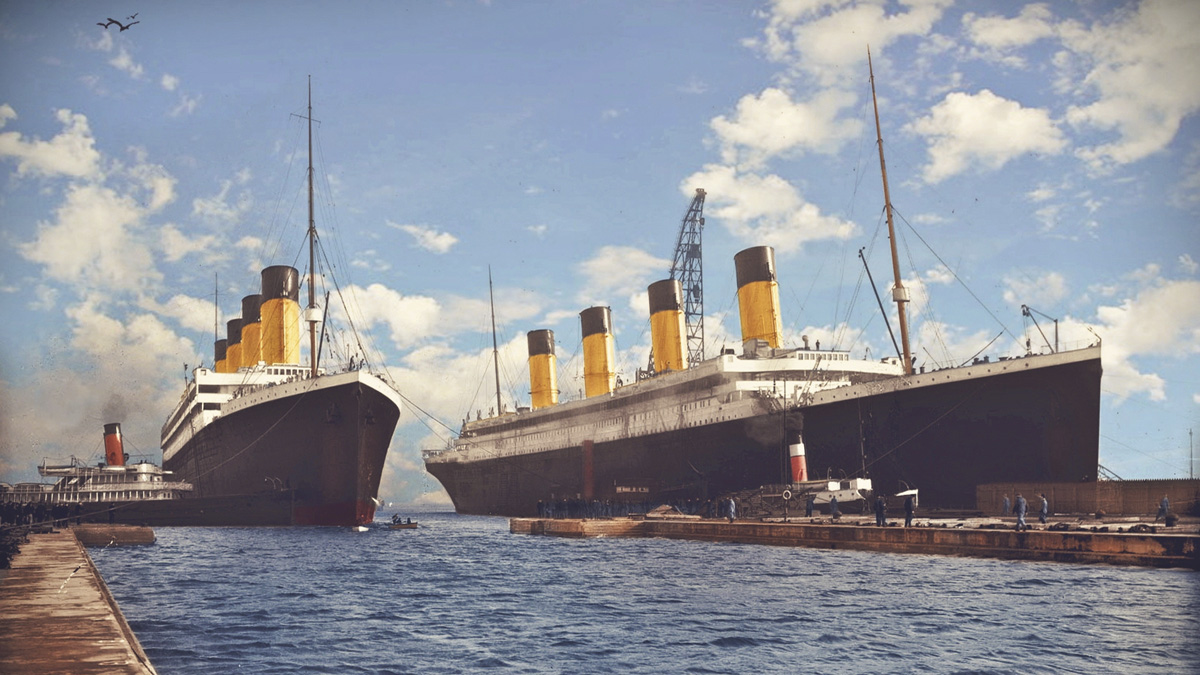
The shape of the front end of a ship today is largely a matter of changing tastes, but a long prow served a practical purpose before the age of engines. On a clipper ship, a long bowsprit was essential for attaching the arrays of ropes and stays that supported masts and raised the sails.
As sail ships got bigger, they got longer and front ends sported a tusk-like bowsprit jutting from the tip, often adorned with carvings of beautiful goddesses or fantastic beasts.
But with the coming of the age of steam around 1880, more knife-like vertical prows came to represent speedy ships– epitomized by White Star Line’s Titanic and her sister ship Olympic — that could slice right through waves.
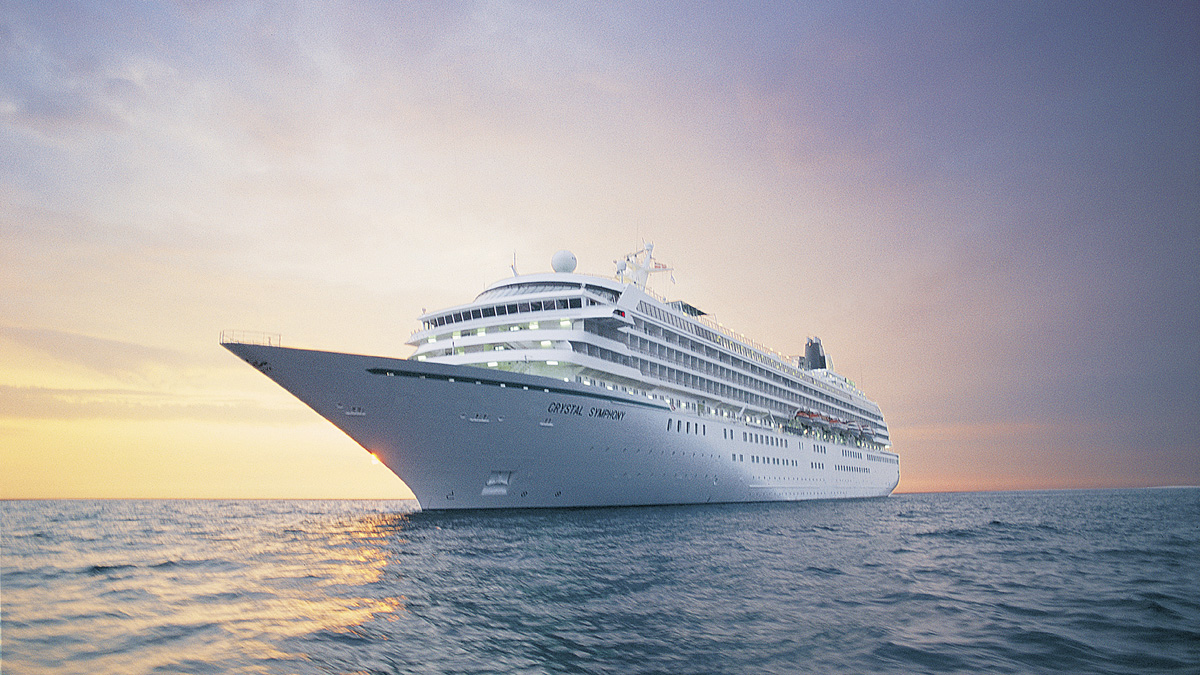
Pointy bows only came back into vogue with the age of streamlining in the 1930s, starting with Cunard Line’s Queen Mary . The fashion probably reached its peak with the dramatically jutting prow of Crystal Cruises’ Crystal Symphony .
Now the tides are turning again.
Cruise designers say a knife-edge bow design is more efficient than a flared bow. It is also said to cause less stress and strain on the vessel as it slices through heavy seas, instead of trying to part them as the usual flared bow does.
There are critics who note that with less ship between the bow and the deck, a vertical prow can make for more water splashing over forward decks. But designers say that’s easily overcome with a higher wall or enclosure around the bow.
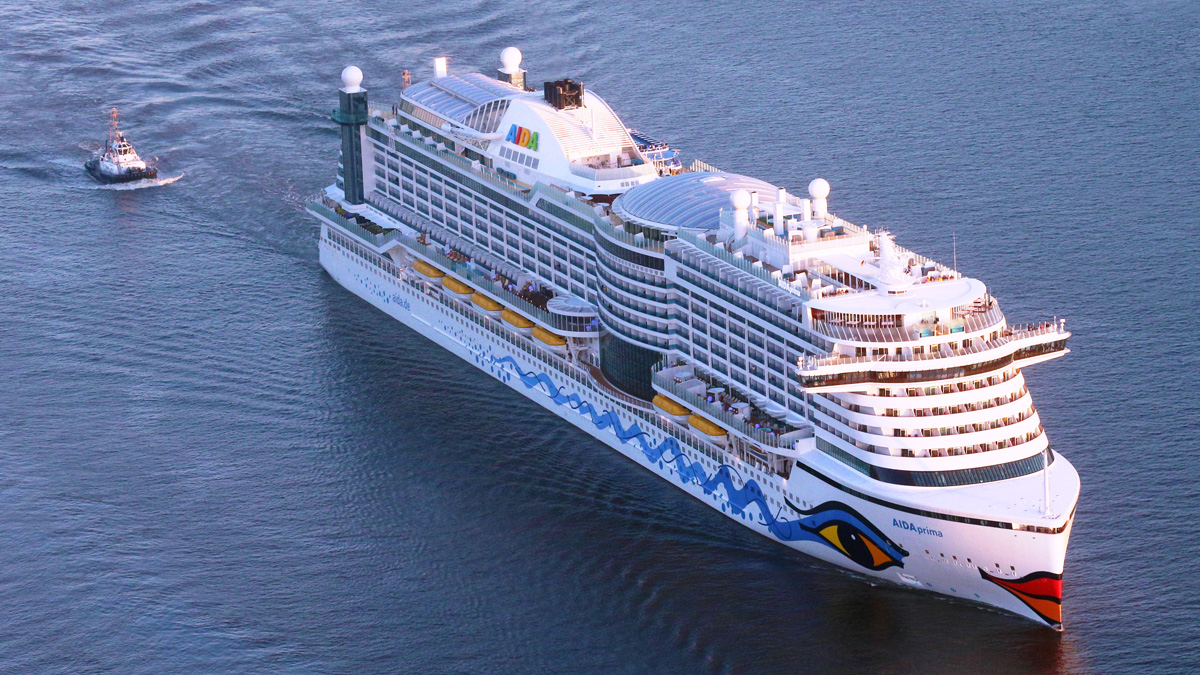
AIDA’s newest leads the trend
The arrival of AIDA Cruises’ AIDAprima in Hamburg in February is the start of a new dynasty. The 3,268-guest ship and a coming sister AIDAperla sport an almost vertical bow design and a covered front deck. The cheeky way AIDA chose to introduce the new look was to paint big puckered red lips around the bow.
Four similar, but larger 5,000-berth ships recently were placed on order by parent company Carnival Corp. for AIDA and sister company Costa Cruises .
Hurtigruten making a big splash
Norwegian exploration travel company Hurtigruten has announced an order of up to four new Arctic-rated ships to meet growing demand. The artist’s sketches show the 600-guest ships will feature very blunt front ends. The first two will debut in 2018 and 2019, and there is an option for two more ships to debut after 2020.
The signing marks the largest investment Hurtigruten has made in its more than 120 years. The new ships will be designed to operate in the Arctic and Antarctic regions as well as along the Norwegian coast. Like the new AIDA ships, they will be equipped with advanced environmental technology to reduce emissions and allow Hurtigruten to meet its sustainability goals.
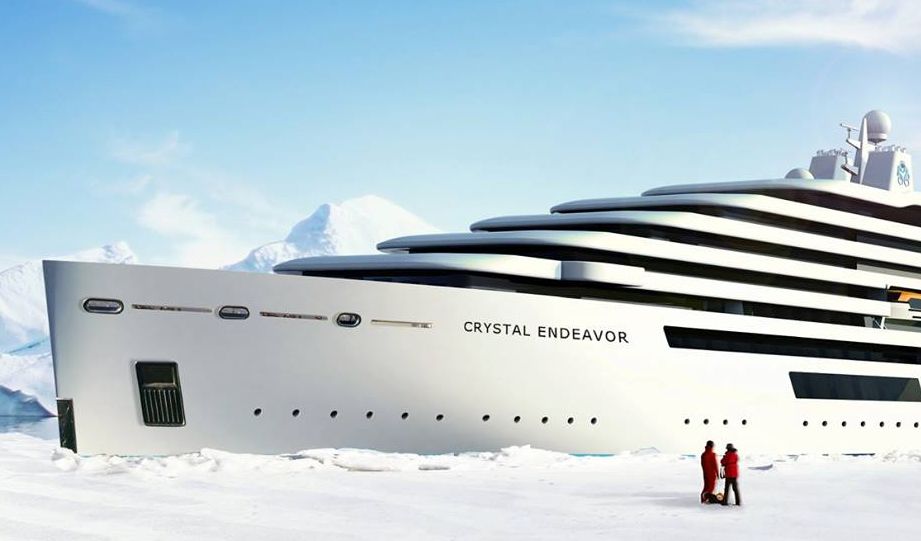
Crystal Cruises chooses the look
The 200-guest polar expedition ship Crystal Endeavor due in 2018 also sports a vertical bow. Being built by Lloyd Werft in Bremerhaven, she will be named for Captain Cook’s ship HMS Endeavor and delivery is scheduled for August, 2018.
Also notable are the new Crystal River Cruises ships that also feature snub noses. While they don’t have to brave rough seas, the design gives them a dramatic appearance. The 106-guest Crystal Bach starts sailing the Rhine in June, to be joined by Crystal Mahler , coming in August. Two more ships arriving in 2018 Crystal Debussy and Crystal Ravel, carry only 78 guests and are designed to sail on the Seine, Garonne, Dordogne and Gironde rivers in France.
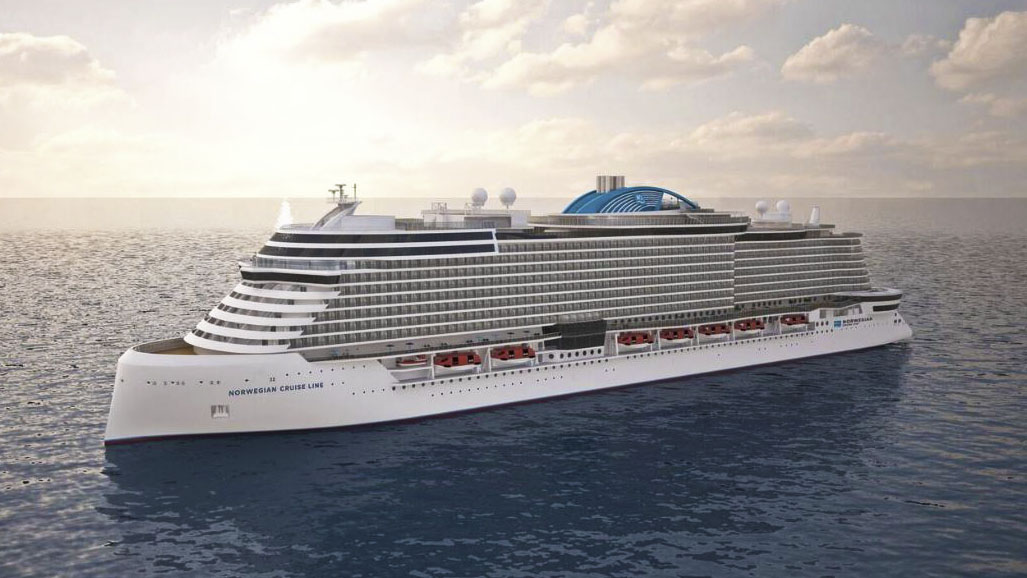
Norwegian’s next generation
Joining the trend, Norwegian Cruise Line signed an agreement in February with Fincantieri S.p.A. shipbuilders to build four next-generation ships to be delivered one a year from 2022 to 2025, with an option for two more to be delivered in 2026 and 2027.
All four ships will be able to carry approximately 3,300 guests and will build on its Breakaway-plus class that includes the cruise line’s latest ship, Norwegian Escape , as well as its next two, Norwegian Joy and Norwegian Bliss.
While few details of the new ships have been released, a preliminary drawing also shows the ships will have nearly vertical bows. While carrying fewer guests than Norwegian’s Breakaway-Plus class, additions will include 12 pools and hot tubs, a “Snow Room” that fills with four inches of snow and a three-story ropes course, the first of its kind at sea, as well as its first Margaritaville restaurant at sea.
This is not a trend to be snubbed.
You might also like:
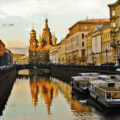
Copyright © 2024 | MH Magazine WordPress Theme by MH Themes
Winter is here! Check out the winter wonderlands at these 5 amazing winter destinations in Montana
- Plan Your Trip
How Does A Cruise Ship Stay Upright
Published: December 10, 2023
Modified: December 28, 2023
by Ulla Yaeger
- Sustainability
Introduction
Have you ever wondered how a massive cruise ship, with its towering size and thousands of passengers, manages to stay upright and stable in the open sea? It may seem like an engineering marvel, but the principles behind a ship’s stability are relatively straightforward. In this article, we will delve into the fascinating world of cruise ship stability, exploring the design elements and systems that keep these behemoths afloat.
At first glance, a cruise ship appears to defy the laws of physics. It is a floating city, a self-contained world that seems impervious to the turbulent forces of the ocean. However, beneath its gleaming exterior lies a careful balance of design and engineering, ensuring that the ship remains stable in even the most challenging conditions.
The stability of a cruise ship is crucial for the safety and comfort of its passengers and crew. It is the result of a complex interplay of factors, including the ship’s design, weight distribution, and stability systems. Understanding these principles will give you a newfound appreciation for the intricate nature of cruise ship construction.
In the following sections, we will explore the basic principles of stability, examine the design factors that contribute to a ship’s stability, and delve into the various systems and technologies employed to maintain stability. We will also take a close look at the impact of weather and waves on a cruise ship’s stability and how it is managed.
So buckle up and get ready to embark on a journey into the fascinating world of cruise ship stability. Let’s uncover the secrets that keep these floating wonders upright and ensure smooth sailing for all who step aboard.
Basic Principles of Stability
To understand how a cruise ship stays upright, we must first explore the basic principles of stability. At its core, stability refers to the ability of a ship to maintain its equilibrium and resist capsizing or rolling over in the water.
The stability of a cruise ship is determined by two main factors: its center of gravity (CG) and its center of buoyancy (CB). The center of gravity is the point where the ship’s weight is evenly distributed, while the center of buoyancy is the point where the buoyant force acts on the ship.
In an ideal scenario, the center of gravity and the center of buoyancy should be aligned vertically. When the ship is at rest, the weight of the ship is balanced by the buoyant force, resulting in a stable equilibrium. However, when external forces like waves or wind act on the ship, the balance can be disrupted.
If the center of gravity is too high in relation to the center of buoyancy, the ship becomes top-heavy and prone to rolling or capsizing. Conversely, if the center of gravity is too low, the ship may become unstable and roll excessively in rough seas.
To ensure optimal stability, cruise ships are designed with a low center of gravity. This is achieved by placing heavy components such as engines, fuel tanks, and machinery in the lower levels of the ship. The lower the center of gravity, the more stable the ship becomes.
Additionally, cruise ships are designed with a wide beam (width) and a large displacement (weight). These factors further contribute to stability by increasing the ship’s resistance to rolling and enhancing its ability to self-right when impacted by external forces.
Another crucial aspect of stability is the concept of the metacentric height (GM). The metacentric height is the distance between the ship’s center of gravity and its metacenter. The metacenter is a theoretical point that determines the ship’s stability characteristics.
A positive metacentric height indicates that the ship is stable, as the metacenter is located above the center of gravity. This means that when the ship tilts due to external forces, a righting moment is generated, causing the ship to return to its upright position. Conversely, a negative metacentric height can lead to instability and excessive rolling.
In summary, the stability of a cruise ship relies on maintaining the proper alignment of the center of gravity and the center of buoyancy, as well as optimizing the metacentric height. These fundamental principles, along with careful design considerations, work together to ensure that a cruise ship remains stable and safe throughout its voyages.
Ship Design and Stability Factors
The design of a cruise ship plays a crucial role in ensuring its stability. Let’s explore some of the key design factors that contribute to a ship’s stability.
One important aspect is the hull form. Cruise ships are typically designed with a broad and flat bottom hull, known as a “double-bottom” design. This design provides greater stability by distributing the ship’s weight over a larger area, reducing the risk of capsizing.
The shape of the hull also affects stability. A rounded hull, known as a “bulbous bow,” helps to minimize resistance and improve stability by reducing the pitching motion of the ship in rough seas. This design feature allows for smoother sailing and enhanced stability, particularly in challenging weather conditions.
The placement of weight on the ship is another critical factor. As mentioned earlier, heavier components such as engines, fuel tanks, and machinery are strategically positioned in the lower levels of the ship to lower the center of gravity. This ensures a more stable and balanced distribution of weight throughout the vessel.
Furthermore, the size and positioning of passenger areas and amenities are taken into account during ship design. These areas are often spread horizontally across the ship, helping to maintain a balanced weight distribution from side to side.
Aerodynamics also play a role in stability. Cruise ships are designed to minimize wind resistance and reduce the potential for destabilizing forces. Sleek and streamlined superstructures help to cut through the wind, reducing the chances of the ship being thrown off balance by strong gusts.
In addition to the design factors, various stability systems are employed on cruise ships to enhance stability and minimize the effects of external forces. These systems include the use of ballast tanks, stabilizers, and bilge keels.
Overall, ship design and stability factors work in tandem to ensure that a cruise ship remains stable and safe throughout its journeys. Through careful consideration of hull form, weight distribution, aerodynamics, and the implementation of stability systems, cruise ship designers create vessels that can withstand the forces of the ocean and provide a comfortable and secure experience for passengers and crew.
Metacentric Height
The metacentric height (GM) is a crucial concept in ship stability. It refers to the distance between the ship’s center of gravity (CG) and its metacenter. Understanding the metacentric height is essential for evaluating a ship’s stability characteristics.
The metacenter is a hypothetical point that represents the intersection of the line of action of the buoyant force with the vertical axis when a ship is heeled (tilted) due to external forces. It is determined by the shape and arrangement of the ship’s hull, as well as the position of the center of gravity relative to the center of buoyancy.
A positive metacentric height indicates a stable condition. In this case, the metacenter is above the center of gravity. When the ship is tilted, a righting moment is generated, causing the ship to return to its upright position. This stability is crucial in maintaining the safety and comfort of passengers and crew.
If the metacentric height is too low or negative, the ship becomes unstable. When the ship heels, the center of gravity shifts to one side, causing the metacenter to shift downward. This results in a diminishing righting moment, making it difficult for the ship to return to an upright position. Excessive rolling can occur, putting the ship at risk of capsizing.
Several factors affect the metacentric height, including the shape and size of the ship’s hull, the distribution of weight, and the position of the center of gravity. Optimizing the metacentric height is a critical design consideration in ship construction.
A higher metacentric height provides greater stability in calm conditions but can result in a more pronounced rolling motion in rough seas. On the other hand, a lower metacentric height reduces rolling motion but compromises stability. Designers must strike the right balance to ensure the ship remains stable and comfortable for passengers, even in challenging weather conditions.
In summary, the metacentric height is a fundamental aspect of ship stability. It determines the ship’s ability to withstand external forces and return to an upright position. By carefully considering the metacentric height during the design process, cruise ships can ensure a safe and enjoyable experience for all on board.
The Role of Ballast
Ballast plays a crucial role in maintaining the stability and balance of a cruise ship. It involves the use of water or other heavy materials to adjust the ship’s weight distribution and center of gravity as needed.
One primary purpose of ballast is to ensure that the ship sits at an optimal level in the water. When a ship is empty or has unloaded its cargo, it may ride higher in the water, resulting in a higher center of gravity. This can compromise stability. By adding ballast, the ship’s weight is increased, lowering the center of gravity and enhancing stability.
On the other hand, when the ship is fully loaded, its center of gravity may be too low, causing it to become less stable. In this case, ballast can be discharged to raise the ship’s center of gravity and restore stability. The proper distribution of ballast is essential to maintain the ship’s stability throughout its voyage, regardless of the varying cargo loads.
Traditionally, ballast was provided by filling dedicated ballast tanks within the ship’s hull with seawater. These tanks, located in the lower parts of the ship, can be emptied or filled as needed to adjust the ship’s weight distribution. However, modern cruise ships often use more advanced systems, such as dynamic ballast systems, which enable more precise control over the ship’s stability.
In addition to maintaining stability, ballast also serves other important functions. It helps improve the ship’s maneuverability by adjusting the ship’s trim, which refers to its longitudinal balance. Uneven weight distribution can make a ship difficult to steer, affecting its performance in narrow passages or during docking procedures. Properly adjusted ballast ensures that the ship maintains the desired trim, making it easier to handle.
Ballast is also essential for the ship’s structural integrity. By adding weight to the ship, ballast helps counteract the bending and twisting forces that can occur during rough weather or wave impacts. This helps to prevent excessive stress on the hull and maintain the ship’s overall strength and integrity.
In summary, ballast plays a crucial role in managing the stability, trim, and structural integrity of a cruise ship. By adjusting the ship’s weight distribution and center of gravity, ballast ensures that the ship remains stable, maneuverable, and capable of withstanding the forces of the ocean. It is a vital component of ship design and operation, contributing to a safe and enjoyable cruising experience.
Stabilization Systems
Stabilization systems are integral to maintaining the comfort and stability of a cruise ship, especially in rough seas. These systems help to minimize the rolling and pitching motion of the ship, enhancing the overall sailing experience for passengers and reducing the risk of seasickness.
One commonly used stabilization system is the use of bilge keels. Bilge keels are long fins that are attached to the lower sides of the ship’s hull. They work by increasing the ship’s resistance to rolling by creating hydrodynamic forces that counteract the rolling motion caused by waves. Bilge keels are particularly effective at reducing the side-to-side motion of the ship.
In addition to bilge keels, cruise ships often employ more advanced and sophisticated stabilization systems. These systems can be categorized into two main types: active stabilizers and passive stabilizers.
Active stabilizers consist of retractable or extendable fins located beneath the waterline on both sides of the ship. These fins can be adjusted in real time to counteract the rolling motion of the ship. They utilize advanced sensors and hydraulic systems to analyze the ship’s movement and apply the appropriate corrective forces to minimize rolling. Active stabilizers are highly effective in providing a smooth and stable sailing experience, even in challenging sea conditions.
Passive stabilizers, on the other hand, work by utilizing the ship’s natural resistance to rolling. These systems often consist of large tanks filled with water or air, strategically placed within the ship’s hull. As the ship starts to roll, the water or air within these tanks flows or compresses, creating a counteracting force that stabilizes the ship. Passive stabilizers are simpler in design and operation compared to active stabilizers but are still effective in reducing rolling motion.
Modern cruise ships often combine both active and passive stabilization systems to provide optimal stability. The active systems can quickly respond to changing sea conditions, while the passive systems provide continuous stabilization without relying on external power sources.
Overall, the implementation of stabilization systems on cruise ships significantly enhances the comfort and safety of passengers. By minimizing the rolling and pitching motion, these systems ensure a smoother sail, reduce the risk of seasickness, and provide a more enjoyable experience for everyone on board.
Bilge Keels
Bilge keels are an important component of a cruise ship’s stability system. These long fins, typically located on the lower sides of the ship’s hull, are designed to reduce the rolling motion caused by waves and enhance stability.
One of the primary functions of bilge keels is to increase the ship’s resistance to rolling. As waves impact the hull, they generate rolling forces that can cause the ship to sway from side to side. Bilge keels work by creating hydrodynamic forces that counteract these rolling forces, helping to reduce the amplitude of the rolling motion.
The shape and size of bilge keels are carefully designed to optimize their effectiveness. They are typically elongated fins that extend horizontally from the lower part of the ship’s hull. The precise dimensions and positioning of the bilge keels are based on extensive calculations and hydrodynamic studies to ensure optimal performance.
When the ship rolls, the bilge keels generate hydrodynamic lift and drag forces that act in opposition to the rolling motion. These forces create a stabilizing effect, making it more difficult for the ship to roll further. The result is a smoother and more stable ride for passengers and crew even in rough seas.
Bilge keels are especially effective in reducing the ship’s rolling motion at low speeds and during maneuvering. They help to dampen the ship’s natural tendency to roll, making it easier to steer and control the vessel in narrow passages or during docking procedures.
In addition to their stabilizing function, bilge keels also offer some incidental benefits. They contribute to the overall structural integrity of the ship by providing additional hydrodynamic support. Bilge keels help to reduce the bending and twisting stresses on the hull, particularly during heavy sea states.
Furthermore, bilge keels can act as protective shields for the ship’s hull. By extending downwards, they provide a level of protection against damage caused by contact with piers, docks, or other vessels. This feature helps to prolong the lifespan of the ship and reduce maintenance costs.
Overall, bilge keels are an essential component of a cruise ship’s stability system. They contribute to the reduction of rolling motion, improve maneuverability, enhance structural integrity, and offer protective benefits. Together with other stabilization systems, bilge keels work to provide a safe and comfortable cruising experience for passengers and ensure the vessel remains stable even in challenging sea conditions.
Active and Passive Stabilizers
Active and passive stabilizers are two types of stabilization systems commonly used in cruise ships to minimize the rolling and pitching motion and improve overall stability in various sea conditions.
Active stabilizers consist of retractable or extendable fins located beneath the waterline on both sides of the ship. These fins can be adjusted in real time to counteract the rolling motion caused by waves. Active stabilizers utilize advanced sensors, such as gyroscopes and accelerometers, to monitor the ship’s movement and apply corrective forces as needed.
When the ship begins to roll, the sensors detect the motion and send signals to hydraulic systems that control the movement of the fins. The fins are adjusted independently based on the detected degree of rolling, deploying maximum resistance to reduce the ship’s rolling motion. This active response to the ship’s movement allows for precise and real-time stabilization, ensuring a smoother sailing experience for passengers regardless of the sea conditions.
Passive stabilizers, on the other hand, work by utilizing the ship’s natural resistance to rolling. These systems typically involve large tanks filled with either water or air, strategically positioned within the ship’s hull. As the ship starts to roll, the water or air within the tanks flows or compresses to create a counteracting force that stabilizes the ship.
The passive stabilizer tanks are strategically designed and positioned to achieve the desired stabilizing effect. The size and weight of the tanks, as well as their placement along the ship’s length and width, are carefully calculated to optimize their effectiveness. Unlike active stabilizers, passive stabilizers do not require complex sensors or hydraulic systems to function, making them a simpler and more reliable option.
The advantage of active stabilizers lies in their capability to actively respond to changing sea conditions. Their adjustability allows for precise control over the ship’s stability, providing an optimal sailing experience even in rough seas. However, active stabilizers are typically more complex and require additional power sources, such as hydraulic systems, to operate.
In contrast, passive stabilizers offer continuous stabilization without the need for external power sources or complex control systems. They rely on the ship’s own resistance to rolling to provide stabilization. Passive stabilizers are generally considered more reliable and require less maintenance compared to active stabilizers.
Many modern cruise ships utilize a combination of both active and passive stabilizers to achieve maximum stability. By integrating both systems, cruise ships benefit from the precise control of active stabilizers and the continuous stabilization of passive stabilizers, ensuring a comfortable and stable sailing experience for passengers in a wide range of sea conditions.
Ultimately, whether active or passive, these stabilizer systems play a vital role in enhancing the safety, comfort, and overall enjoyment of a cruise ship journey, allowing passengers to fully relax and embrace the experience without the disturbance of excessive rolling or pitching motions.
The Effect of Weather and Waves
The weather and waves have a significant impact on the stability and sailing experience of a cruise ship. Understanding how these factors can affect a ship’s stability is crucial for both the ship’s designers and passengers.
When it comes to weather, strong winds can pose a challenge to the stability of a cruise ship. As wind pushes against the superstructure and sail area of the ship, it creates a turning moment that can cause the ship to roll or heel to one side. This can lead to a temporary loss of stability and potentially make passengers feel uncomfortable.
Waves are another important consideration, as their height, frequency, and direction can greatly influence a ship’s stability. A wave passing under a cruise ship applies an upward buoyant force, lifting the ship. However, as the wave progresses, it exerts a downward force, potentially causing the ship to pitch or surge. This motion can be felt by passengers and can affect their comfort level on board.
The size and shape of waves also play a role in ship stability. Larger waves have more energy and can generate greater forces on the hull. Steeper waves, known as rogue waves, can be particularly challenging as they can lead to sudden and severe rolling motions.
To mitigate the effects of weather and waves, cruise ships are equipped with various stabilization systems, as mentioned earlier. Bilge keels, active stabilizers, and passive stabilizers all work to counteract the rolling motion caused by these external forces. These systems help to maintain the ship’s stability and reduce the discomfort passengers may feel due to rough weather or high waves.
In addition to stabilization systems, modern cruise ships are built with advanced weather monitoring and forecasting systems. These systems allow the ship’s crew to anticipate and plan for inclement weather, adjusting the ship’s course or speed to avoid the most challenging conditions. By utilizing real-time weather data, cruise ships can optimize their routes for the comfort and safety of passengers.
Furthermore, cruise ships undergo rigorous testing and certification processes to ensure their stability and safety in various weather conditions. These tests involve simulating extreme weather scenarios to evaluate the ship’s performance and stability limits. By adhering to international safety standards, cruise ships are designed to withstand rough seas and provide a stable sailing experience for passengers.
While weather and waves can have an impact on a cruise ship’s stability, it’s important to note that cruise ships are built to withstand challenging conditions. By utilizing advanced stabilization systems, monitoring weather patterns, and adhering to strict safety standards, cruise ships provide a safe and enjoyable sailing experience for passengers, even in less favorable weather and wave conditions.
Cruise ships are engineering marvels that defy gravity and provide a comfortable and luxurious experience for passengers at sea. The stability of these floating cities is vital for the safety and well-being of everyone on board. Through careful design, utilization of stability factors, and implementation of stabilization systems, cruise ships are built to withstand the forces of nature and maintain equilibrium even in challenging conditions.
The basic principles of stability, such as the center of gravity and buoyancy, metacentric height, and weight distribution, form the foundation of cruise ship design. By optimizing these factors, ship designers create vessels that can resist rolling and maximize stability. The shape and design of the hull, the placement of weight, and the implementation of technologies like bilge keels all contribute to maintaining stability at sea.
Stabilization systems, such as active and passive systems, provide additional support by counteracting the rolling motion caused by waves and wind. Active stabilizers, with their real-time adjustment capabilities, and passive stabilizers, with their continuous stabilizing effect, work together to ensure a smooth and enjoyable sailing experience for passengers.
Weather and waves can present challenges to cruise ship stability, but advanced monitoring systems and meticulous planning enable ships to navigate safely through varying conditions. By utilizing weather forecasting technology, cruise ships can alter their routes to avoid the most adverse weather conditions, enhancing passenger comfort and safety.
In conclusion, the stability of a cruise ship is a result of careful design, adherence to stability principles, and the integration of robust stabilization systems. These elements work together to ensure that cruise ships remain steady, even in rough seas. Passengers can embark on their journeys with confidence, knowing that their safety and comfort are top priorities for the cruise ship industry. So, sit back, relax, and enjoy the smooth sailing experience on your next cruise adventure.

- Privacy Overview
- Strictly Necessary Cookies
This website uses cookies so that we can provide you with the best user experience possible. Cookie information is stored in your browser and performs functions such as recognising you when you return to our website and helping our team to understand which sections of the website you find most interesting and useful.
Strictly Necessary Cookie should be enabled at all times so that we can save your preferences for cookie settings.
If you disable this cookie, we will not be able to save your preferences. This means that every time you visit this website you will need to enable or disable cookies again.

Types of Bow Designs Used For Ships
Think of the most beautiful ship you might have ever seen, imagined, or let’s say the one which happened to capture your imagination the most.
It goes to say without mention that one feature of ships which never ceases to fascinate is – The Bow.
The foremost part of the ship is part aesthetics and part science. Your ship travels in a medium that provides considerable drag as compared to air.
Now, this requires the design to be such that the components of ship resistance are kept less. Especially, in the case of ships with fuller forms, components of Wave Breaking Resistance become significant, while ships with a slender and a more curved form have less Wave Making Resistance.
Fortunately, these can be controlled by how the water and waves interact with the ship at entry at the fore-end. The ship bow is where the fore part of the ship first comes in contact with the water as far as your design waterline is considered.
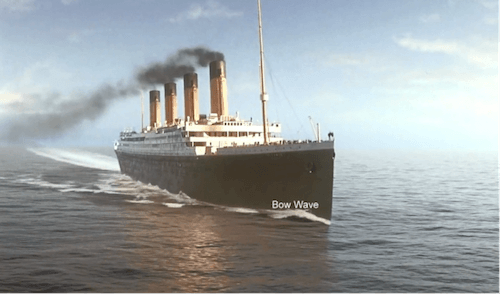
Looking at the different Ship Bow Designs in existence today, it seems that most of the shapes possible and a combination of two or more of them have been tried out.
However, newer designs have emerged and older lesser-used designs have often been tried out with certain changes after extensive analysis.
Still, broadly speaking, some of the bow design types are:
- The Bulbous Bow
- A Normal Bow without a Bulb
- Other Special Bows
The Plumb, the Clipper and the Spoon
A normal bow, as what we would call it, has developed from its predecessor which was a vertical bow. The angle at which the ship stem makes with the waterline is called the rake .
A vertical, or unraked bow having a straight edge is known as a plumb bow . These bows have maximum waterline besides an X-Bow or an Inverted Bow. This length of the waterline allows for a greater hull speed .
Bow rakes are used in conjunction with flares (Remember I mentioned imagining your ship? I guess you won’t forget the outward stretching hull form at the top, this is what we call flaring ).
Flaring has its own benefits like keeping water off the decks and also eases the pitching motions. Some raking also sets up what is called ‘ Crumple Zones ’ allowing safety against collisions before the submerged portion comes in contact with it.
Stability-wise, it raises the Centre of Buoyancy, which in turn increases the GM – one of the pillars of ship stability. Traditionally these have been called the Clippers.
As the name suggests, a Spoon Bow resembles a spoon by giving a concave appearance at the stem and deck line.
These forms often have chining and curvature at the waterline creating their characteristic wake pattern, bringing Wave Making Resistance into the picture.
Bulbous Bow
A very familiar unit in bow sections of almost all seagoing cargo ships and vessels with fuller forms is – The Bulbous Bow .
This staple of ship designs today was said to have been discovered rather than being invented. Military towing tests in the USA showed that for a boat model having a torpedo discharge pipe extending forward also lowered the resistance. The first civil ships were seen in the 1930s.
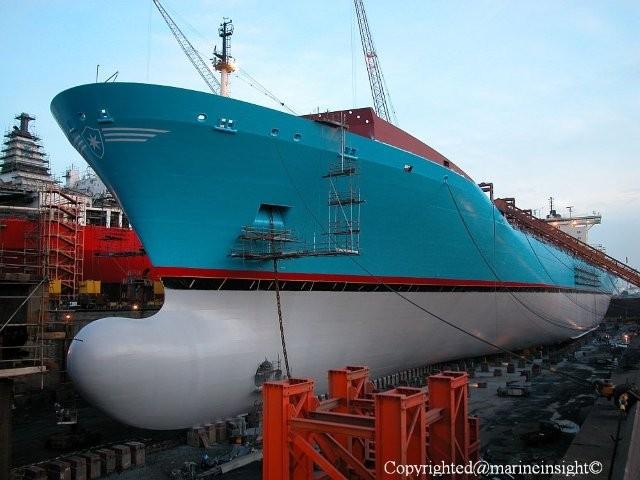
Bulbous Bows are studied using their own form characteristics and these might spring up in your ship resistance and powering calculations so you might want to consider some of them like the shape of the section, area ratios , length of the projection and the like.
The Bulbous Bow can reduce slamming on your ship and have the same effect as a normal bow in a ballasted condition if a sharply tapering bulb section is used.
Depending upon your ship form as mentioned above, the Bulb axis is also important as it affects your wave influence at entry, and if you keep your axis such that it slopes downwards stern, it will allow better flow characteristics.
Ships with fuller forms have high wave breaking resistance, and this element that eats away your propulsive efficiency can be greatly reduced by using a Bulbous Bow with a sharply downward tapering water-plane.
These Bows also allow better recovery of energy by the propeller as energy losses due to vortices at the fore-end is minimised.
Parabolic and Cylindrical Bows
Sometimes designers consider designing vessels with ‘blunt’ stems as opposed to the sharp nature of the bow section. Here is the Parabolic Bow, which resembles the mathematical curve, the Parabola.
Now, recall some high school math, the semi-minor axis of the ellipse is what would be the beam of the ship.
Sometimes only designing a parabolic shape for a ship hull is not enough, you have to see the flow around the hull and for this, give it a typical rounded form like a normal round bilged hull.
Parabolic Bows may be combined with Bulbs to take the Wave Breaking Resistance into account as these are popular in fuller form designs and are being used in Bulk Carriers today.
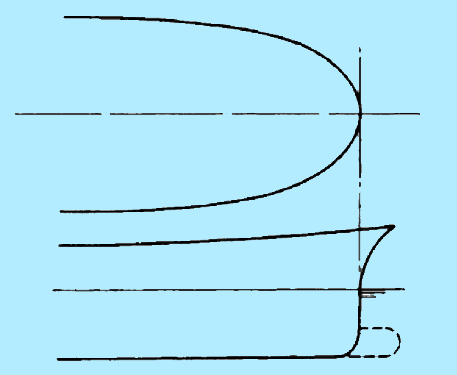
The closest cousin to these is the cylindrical ship bows which are also designed for fuller forms at design waterlines and are ideal for use in fully loaded conditions.
The Cylindrical Bows can have minimal Wave Making Resistance if designed with proper attention to the bluntness of form and stem edge at different drafts.
The Axe Bow
While an axe does its job, cutting wood, or maybe something as obvious, the ship bow bearing resemblance to it has its own characteristic features.
This design usually has a vertical stem line coupled with a long, deep and narrow fore portion of the hull, somewhat like an axe.
This shape allows it to cut through the water, allowing it to pass easily through waves with less pitching as opposed to a normal bow.
The lower portion of the fore-end of the hull, called the forefoot rarely emerges out of the water and hence the vessel is less susceptible to slamming also.
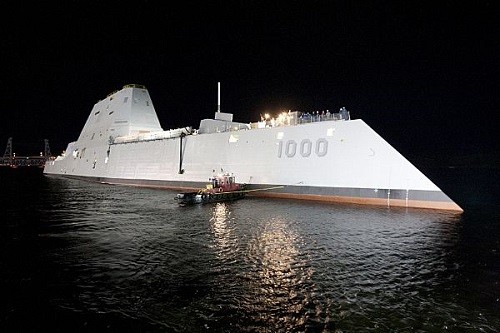
On the other side, certain manoeuvring aspects need to be taken to account, a vessel with an Axe Bow requires more rudder motion as is confirmed by the study of its hydrodynamic parameters.
X-Bow: The Generation of Inverted Bows
How about a design where your ship’s bow and almost a greater part of the hull appears upside down in comparison to a normal round bilge hull or any of the hull shapes you generally see on ships? The inverted bow is a success story among the revival of technologies that became obsolete in a different era.
These hull forms have the advantage of allowing maximum length waterline for ships of comparable sizes which means the highest possible hull speeds .
Like the Axe Bow, these bows have less spray of water at entry and also have less pitching motions and slamming reduction is quite significant. This creates quite a comfortable experience for the crew.
The fuel consumption is also reduced by a significant factor and this bow can operate quite efficiently in medium-sized wave ranges mainly because of the larger part of the ship volume being above and upfront, directly impacted upon by the waves.
These hull forms also double up as decks with accommodation space for the personnel. However, the applicability of these designs for the same level of improvement in speed losses in the roughest of seas must be an area of ongoing work.
Keeping that aside, these vessels have been applied to various applications like the AHTS (Anchor Handling Tug Supply) vessels, Seismic Vessels, Offshore and Pipelay Vessels, drillships and the likes.
These are the most commonly used ship Bow Designs today. Most probably, any vessel you see out there will have any one of the designs you just read about.
Do you know some more salient features of the different Bow Designs in practice today?
Let us know more in the comments below.
Disclaimer : The information contained in this website is for general information purposes only. While we endeavour to keep the information up to date and correct, we make no representations or warranties of any kind, express or implied, about the completeness, accuracy, reliability, suitability or availability with respect to the website or the information, products, services, or related graphics contained on the website for any purpose. Any reliance you place on such information is therefore strictly at your own risk.
In no event will we be liable for any loss or damage including without limitation, indirect or consequential loss or damage, or any loss or damage whatsoever arising from loss of data or profits arising out of, or in connection with, the use of this website.
Do you have info to share with us ? Suggest a correction
Related Articles
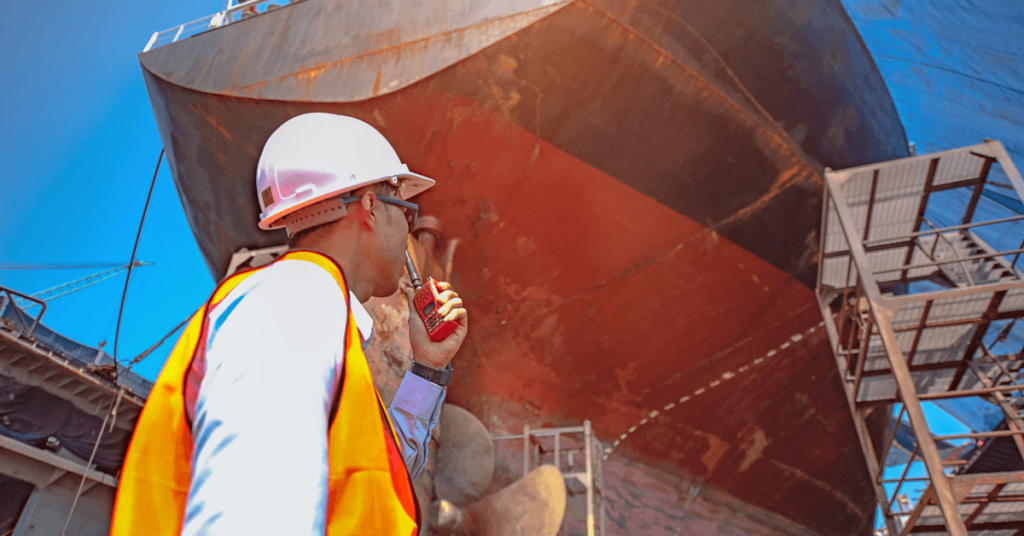
9 New Aspects of IACS Harmonised Common Structural Rules (CSR) For Ships
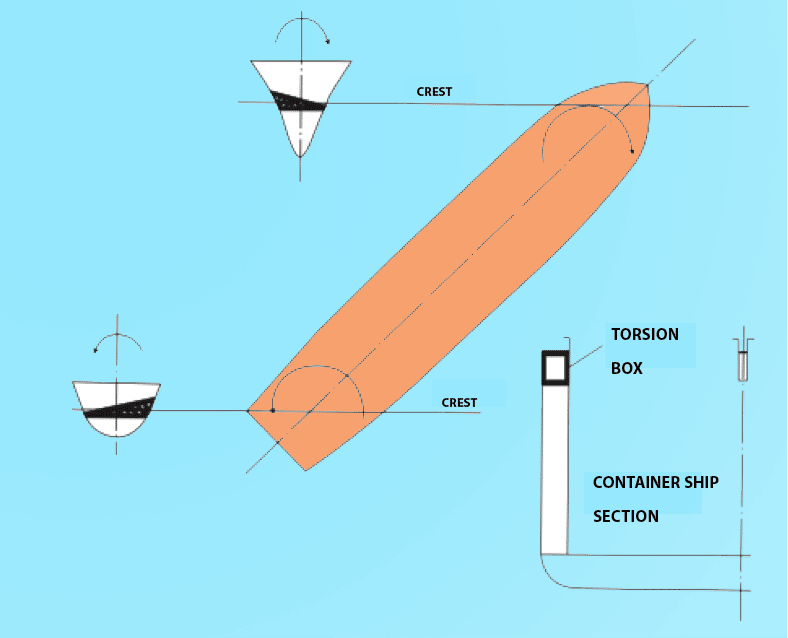
What Is The Purpose Of “Torsion Box” In Ships?
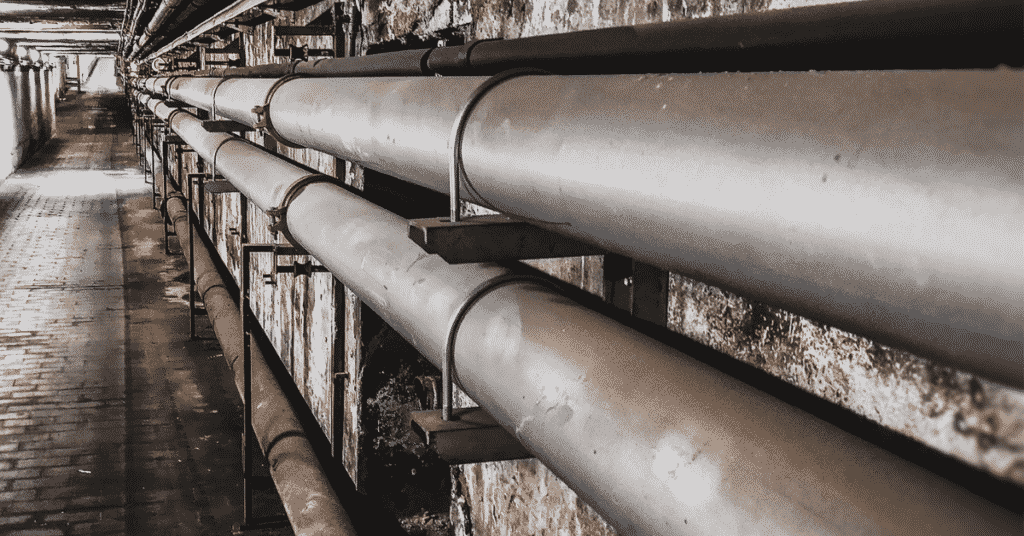
What is Cofferdam on Ships?

About Author
Sudripto is pursuing Naval Architecture and Ocean Engineering at IMU, Visakhapatnam, India. He is an aspiring future Naval Architect with an eye for aesthetics and detail and likes to spend his free time writing maritime blogs and reading about maritime innovations which continue to intrigue him. He is also a Senior Editor at Learn Ship Design- A Student Initiative.
Read More Articles By This Author >
Daily Maritime News, Straight To Your Inbox
Sign Up To Get Daily Newsletters
Join over 60k+ people who read our daily newsletters
By subscribing, you agree to our Privacy Policy and may receive occasional deal communications; you can unsubscribe anytime.
BE THE FIRST TO COMMENT
I like the X-BOW, it gives the Bridge Crew better Forward Visibility. Not having to Second-Guess what’s sitting 600 to 900-feet in front of you. It looks Strange, but I can live with Strange…
what is the name for the hood or cover over the foredeck area used to shed water. Not talking about a breakwater, but a large metal roof.
How about Vard’s bows? They are pretty cool i think
“However the applicability of these designs for the same level of improvement in speed losses in the roughest of seas must be an area of ongoing work” -nope it NOT true! -all X-bow’s have higher speed in higher wakes since they do not Pitch very much! -the famous YOUTUBE clip shows Bourbon Orca sails form two conventional designed PV’s!( https://www.youtube.com/watch?v=-YrSi5Pf_l8 ). -So to lower speed and they need more ongoing work at ULSTEIN… -Its pretty perfect design… It breaks the wakes behind the bow and its a stronger structure hull design -can take much higher shear loads! -they have life span expectation of 40 years in the North Sea alone! -and inspirations came from the Oseberg Viking ship and Viking Naval architects likely got their inspirations from watching Sea Birds -like Ducks or Swans -they ride waves pretty good!!
And first REALLY clear designed with a”Torpedo bulbous Bow” was the Japanese Imperial Navy “Yamato class” -and its first of all about reducing the aft wake or drag! -then comes the other benefits, but the first for purpose designed”wake reduction bow” where design just before WW1! by Italians Navy Architects. -But can be seen on European War ship earlier but what is for ramming!
Was the X-BOW design the result of testing models in enclosed water filled test basins ? Is there mathematical hydrodynamics that wouוld predict such energy saving results ?
what should be he bow angle in a canoe made of concrete ?
Please be aware I’m no expert naval architect. Question: How do all of the bow designs handle in a following and beam on sea? By commenting how ell they perform with a head on sea is all good news, but, you do have to turn around and head back. It’s not all about a head sea.
Hey Andy the thing is called a helipad You peanut… what a forehead slapping moment when I read your question. Deeeerrrrrppppp
I should truly be interested in the performance of a dual-hull, smaller faced, longer-keeled ship, with a large, multidecked center structure, similar to the Swath concept. I truly anticipate amazing speed and efficiency for the tonnage.
Leave a Reply
Your email address will not be published. Required fields are marked *
Subscribe to Marine Insight Daily Newsletter
" * " indicates required fields
Marine Engineering
Marine Engine Air Compressor Marine Boiler Oily Water Separator Marine Electrical Ship Generator Ship Stabilizer
Nautical Science
Mooring Bridge Watchkeeping Ship Manoeuvring Nautical Charts Anchoring Nautical Equipment Shipboard Guidelines
Explore
Free Maritime eBooks Premium Maritime eBooks Marine Safety Financial Planning Marine Careers Maritime Law Ship Dry Dock
Shipping News Maritime Reports Videos Maritime Piracy Offshore Safety Of Life At Sea (SOLAS) MARPOL
WAIT! Did You Download 13 FREE Maritime eBooks?
Sign-up and download instantly!
We respect your privacy and take protecting it very seriously. No spam!
WAIT! Did You Download 12 FREE Maritime eBooks?

New dimension in vertical transportation on Carnival Horizon
BARCELONA -In a stream of passengers boarding the new Carnival Horizon, I entered an elevator for a ride to my assigned cabin, only to become a prisoner to a lift with a brain but no buttons.
The door closed quickly. Nearly a dozen of us, seemingly trapped in an elevator without controls, began rising to who knew where.

Carnival cruisers: Get ready for brainy lifts at sea that may know more about where you are going than you do.
Carnival Horizon, which begins cruising out of PortMiami to the Caribbean on Sept. 22, is the first ship built for the North America market that is full of so-called smart elevators, 33 of them promising faster times, fewer stops, and a new dimension in vertical transportation.
Instead, my elevator rose from the embarkation point directly to Deck 10, taking me and my fellow prisoners swiftly to a lunch buffet — a brilliant plan though a bit disconcerting for the unaware.
Within a few days of cruising, however, the bewildered were few.
Most passengers seemed comfortable with using touch pads in the elevator lobbies to indicate their intended deck destination, then follow instructions to locate the correct blinking light to enter the proper elevator.
The 3,960-passenger Carnival Horizon arrived in New York from Europe May 23 for its naming ceremony. The event featured the ship’s godmother, actress and Grammy-winning singer/rapper Queen Latifah.
The ship is doing cruises out of New York for the summer on four-night Bermuda and eight-night Caribbean voyages. Starting in September, Carnival Horizon will do Caribbean cruises year-round out of Miami, alternating between six and eight nights.
Barbecue, new craft beers, more Dr. Seuss

Once you get the hang of the elevators, moving around this ship is relatively easy, as most restaurants, lounges, and the casino are grouped on two decks. Navigating the vessel will be a familiar exercise for anyone who has sailed on sister ship, Carnival Vista, which launched in 2016.
My favorites among the new toys and attractions on Carnival Horizon center around barbecue, new craft beers, and more Dr. Seuss than you might imagine.
On Horizon, Carnival introduces Guy’s Pig & Anchor smokehouse and brewhouse.
The restaurant, larger and better provisioned than the brewpub on Carnival Vista, may well be cruising’s best seaside roadhouse — with a masterful mixing of new craft beers, live country music, and a terrific menu of smoky barbecue from the artistry of Guy Fieri .
The energetic chef Fieri, a Food Network TV star, is the man who boosted passenger consumption of hamburgers on Carnival Cruise Line ships to 5 million complimentary burgers a year, says Carnival — cooked on many a pool deck, served loaded and juicy.
Fieri was the right Guy to develop Carnival Horizon’s barbecue, prepared in a pair of custom-made smokers. Guy’s Pig & Anchor is well worth an evening, with gentle fees for food — $4 for starters such as chicken wings and trash can nachos, $6 for pig and brisket melt, $8 for the half slab of ribs, and $2 for such sides as sweet potato bourbon mash.
This joint is a hit.

The winning barbecue formula includes pairings with four new ParchedPig craft beers, concocted on the ship by Carnival’s brewmaster, Colin Presby. Best to taste test the four brews first, ordering a ParchedPig flight starting with a toasted amber ale and finishing with a robust smoked porter.
Tip : Get a free tasting of Guy’s Pig & Anchor barbecue at lunch on embarkation day and on sea days, served on the promenade deck outside the smokehouse/brewhouse. Smart elevators are programmed to go there, too.
The other character who plays an increasing role on Carnival Horizon is Dr. Seuss.
The delightful imaginary characters of the fictional Dr. Seuss have become major elements on Carnival Cruise Line ships and are included in family programs for children, starting with interactive story times and character breakfasts that are available on various Carnival cruises.

On Horizon, Dr. Seuss has his own WaterWorks waterpark, which consumes a major portion of the top decks. It’s a fun play area with brightly painted blue, red, yellow and green Dr. Seuss images.
Great gobs of water — 300 gallons in fact — tumble from a giant tipping bucket, and water scoots down dueling slides of differing difficulty and height restrictions — Fun Things, 42 inches; Cat’s Hat, 48 inches.
The Dr. Seuss WaterWorks sits high and splendidly, mid-ship starting on Deck 12, which is what you would choose on a lobby key pad to activate the new-fangled elevators.
You might be tempted to test the level of elevator intelligence, as I was, saying, “Hey, Elly, lift me up to the doctor of fun.” But don’t get your One Fish, Two Fish, Red Fish, Blue Fish hopes up.
These elevators are not that smart.
This blog was published in the Miami Herald
David Molyneaux writes regularly about cruising news, tips and trends at TravelMavenBlog.com . His cruise trends column is published in U.S. newspapers, including the Miami Herald, Dallas Morning News, and on Internet sites, including AllThingsCruise . He is editor of TheTravelMavens.co m
Leave a Comment Cancel reply

All Things Cruise is dedicated to the joy of travel. Specializing in ocean, river, ultra-luxury, small ship and expedition cruises.
We would love to have you subscribe for travel updates, news and great offers directly from the cruise lines!

- Favorites & Watchlist Find a Cruise Cruise Deals Cruise Ships Destinations Manage My Cruise FAQ Perfect Day at CocoCay Weekend Cruises Crown & Anchor Society Cruising Guides Gift Cards Contact Us Royal Caribbean Group
- Back to Main Menu
- Search Cruises " id="rciHeaderSideNavSubmenu-2-1" class="headerSidenav__link" href="/cruises" target="_self"> Search Cruises
- Cruise Deals
- Weekend Cruises
- Last Minute Cruises
- Family Cruises
- 2024-2025 Cruises
- All Cruise Ships " id="rciHeaderSideNavSubmenu-4-1" class="headerSidenav__link" href="/cruise-ships" target="_self"> All Cruise Ships
- Cruise Dining
- Onboard Activities
- Cruise Rooms
- The Cruise Experience
- All Cruise Destinations " id="rciHeaderSideNavSubmenu-5-1" class="headerSidenav__link" href="/cruise-destinations" target="_self"> All Cruise Destinations
- Cruise Ports
- Shore Excursions
- Perfect Day at CocoCay
- Caribbean Cruises
- Bahamas Cruises
- Alaska Cruises
- European Cruises
- Mediterranean Cruises
- Royal Destinations
- Cruise Planner
- Make a Payment
- Check-In for My Cruise
- Beverage Packages
- Shore Excursions
- Update Guest Information
- Book a Flight
- Dining Packages
- Royal Gifts
- Required Travel Documents
- Transportation
- Book a Hotel
- Redeem Cruise Credit
- All FAQs " id="rciHeaderSideNavSubmenu-7-1" class="headerSidenav__link" href="/faq" target="_self"> All FAQs
- Boarding Requirements
- Future Cruise Credit
- Travel Documents
- Check-in & Boarding Pass
- Transportation
- Perfect Day at CocoCay
- Post-Cruise Inquiries
- Royal Caribbean
- Celebrity Cruises

REVOLUTIONARY ADVENTURE
Symphony of the seas.
Go big on bold when you sail aboard one of the largest cruise ships in the world.
Get ready for a perception remixing, memory maxing mic drop — Symphony of the Seas® is all that and more. It’s your favorite onboard hits, including the ten-story test of courage, Ultimate Abyss℠ and twin FlowRider®* surf simulators, plus revolutionary firsts, like glow-in-the-dark laser tag. And deck-defying attractions aren’t the only things to look forward to when you sail onboard this Oasis Class ship. Symphony of the Seas® is also loaded with delicious ways to tempt your taste buds — like the gameday game changing Playmakers℠ Sports Bar & Arcade — and larger-than-life ways to stay, like the Ultimate Family Suite. Go get your thrill on.
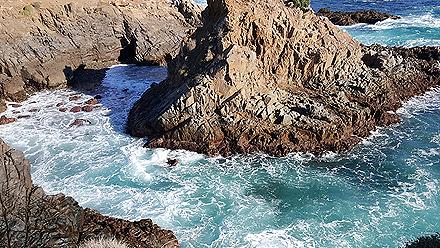
Tune Into The Sound Of Adventure
Save big on these bestselling itineraries.
{{error.text}} {{error.link.label}}
SIGN UP TO STAY IN THE LOOP
Sign up to receive information about our special offers and deals. You can unsubscribe at any time. For more details about how we use your information, view our Privacy Policy .

THIS IS THE SOUND OF FIRSTS
Get ready for revolutionary new firsts, like glow-in-the-dark Laser Tag , the gameday game changing Playmakers℠ Sports Bar & Arcade , and the Ultimate Family Suite .

Game Changers
Glow-in-the-dark laser tag, two surf simulators and the tallest slide at sea? You’re going to want to bring your game face.
EXPLORE ONBOARD ACTIVITIES

a foodie fantasy
If you’re craving high-end eats, Symphony of the Seas® hits all the high notes. Fresh caught New England-style seafood, family style Italian from Jamie Oliver and much more.
EXPLORE ONBOARD DINING

MARQUEE SHOWS
Catch jaw-dropping performances on stage, ice, water and air with entertainment that transcends the stage — literally.
EXPLORE SHOWS & ENTERTAINMENT

GET READY TO TURN UP THE CARIBBEAN CRAZE
Get ready for memory-maxing with a whole lot of whoas onboard Oasis Class favorite, Symphony of the Seas ®. Visit the best of the western and southern Caribbean with adventure-packed itineraries and nonstop island hops sailing from Fort Lauderdale and Cape Liberty — for the first time.
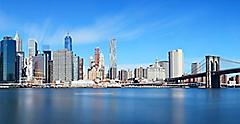
ADVENTURES FROM THE NORTHEAST
For the first time ever, Symphony of the Seas ® sails from Cape Liberty to captivating destinations. Kayak past manatees in Orlando. Snorkel in turquoise waters in Nassau . And experience a beach day full of record-breaking thrills and epic ways to chill at Perfect Day at CocoCay — voted best private island three years running.
EXPLORE CRUISES FROM CAPE LIBERTY
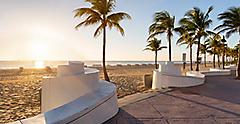
THRILL TOPPING, ISLAND HOPPING
Sun-kissed Caribbean shores are yours to explore onboard Symphony of the Seas ® sailing from Fort Lauderdale. Go cave chasing in Curaçao one minute. Then deep dive into Aruba’s colorful underwater world the next. Or savor a famous Jamaican meat patty. And dial up thrills on a zip line ride over the ocean in Labadee — our gamechanging private destination.
EXPLORE CRUISES FROM FORT LAUDERDALE
MEET THE WORLD'S BIGGEST, BOLDEST SHIPS
These engineering wonders take home awards every year for their cutting-edge design, first-of-their-kind attractions, world class dining and accommodations, and unforgettable experiences. From the tallest slide at sea, to culinary concepts that take guests from Japan to Italy to Wonderland, the world’s largest cruise ships are full of adventures guaranteed to wow every kind of explorer.
EXPLORE OUR OASIS CLASS SHIPS
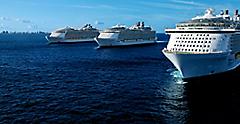
CRUISE SHIP SYMPHONY OF THE SEAS REVIEWS
Explore more.
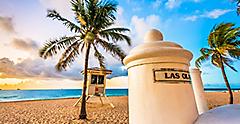
Previewing: Promo Dashboard Campaigns
My Personas
Code: ∅.
- Skip to main content
- Keyboard shortcuts for audio player
The Two-Way
International, mission success: costa concordia is vertical.
Doreen McCallister

Sylvia Poggioli

The Costa Concordia is seen after it was lifted upright on the Tuscan Island of Giglio, Italy, early Tuesday morning. Officials declared the results of the 19-hour operation "perfect." Andrew Medichini/AP hide caption
The Costa Concordia is seen after it was lifted upright on the Tuscan Island of Giglio, Italy, early Tuesday morning. Officials declared the results of the 19-hour operation "perfect."
In an operation that took 19 hours, the luxury cruise ship Costa Concordia is now in an upright position.
The head of Italy's Civil Protection agency, Franco Gabrielli, announced the ship had reached vertical and that the operation to rotate it was complete, according to The Associated Press .
The process to right the ship is known in nautical terms as parbuckling. That maneuver is used all the time to right ships but this is the first time it had been used on such a huge cruise ship.
NPR's Sylvia Poggioli, who's on the Italian island of Giglio, reports local residents greeted salvage master Nick Sloane as a hero. He led the team of more than 500 divers, technicians and engineers.
The operation was expected to take 10 to 12 hours, but extra time was needed. ( Note at 10:45 a.m. ET: Reuters has turned off its live webcast of the parbuckling operation. Instead, it now has time-lapse video showing the ship being shifted into an upright position.)
The ship ran aground in January 2012 off the coast of Tuscany. Thirty-two people died, and two of the bodies have not been recovered.
The ship, which is twice the size of the Titanic, will be stabilized and checked to make sure it can make it through the harsh winter. In the spring, the vessel will be floated to a scrap yard.
The cruise ship's captain, Francesco Schettino, is on trial for the incident . He's charged with manslaughter, causing a shipwreck and abandoning ship. Schettino claims the reef where the ship ran aground was not on nautical charts.
- Costa Concordia
- parbuckling
- Images home
- Editorial home
- Editorial video
- Premium collections
- Entertainment
- Premium images
- AI generated images
- Curated collections
- Animals/Wildlife
- Backgrounds/Textures
- Beauty/Fashion
- Buildings/Landmarks
- Business/Finance
- Celebrities
- Food and Drink
- Healthcare/Medical
- Illustrations/Clip-Art
- Miscellaneous
- Parks/Outdoor
- Signs/Symbols
- Sports/Recreation
- Transportation
- All categories
- Shutterstock Select
- Shutterstock Elements
- Health Care
- Sound effects
PremiumBeat
- PixelSquid 3D objects
- Templates Home
- Instagram all
- Highlight covers
- Facebook all
- Carousel ads
- Cover photos
- Event covers
- Youtube all
- Channel Art
- Etsy big banner
- Etsy mini banner
- Etsy shop icon
- Pinterest all
- Pinterest pins
- Twitter All
- Twitter Banner
- Infographics
- Zoom backgrounds
- Announcements
- Certificates
- Gift Certificates
- Real Estate Flyer
- Travel Brochures
- Anniversary
- Baby Shower
- Mother's Day
- Thanksgiving
- All Invitations
- Party invitations
- Wedding invitations
- Book Covers
- About Creative Flow
- Start a design
AI image generator
- Photo editor
- Background remover
- Collage maker
- Resize image
- Color palettes
Color palette generator
- Image converter
- Creative AI
- Design tips
- Custom plans
- Request quote
- Shutterstock Studios
- Data licensing
You currently have 0 credits
See all plans

Image plans
With access to 400M+ photos, vectors, illustrations, and more. Includes AI generated images!

Video plans
A library of 28 million high quality video clips. Choose between packs and subscription.

Music plans
Download tracks one at a time, or get a subscription with unlimited downloads.
Editorial plans
Instant access to over 50 million images and videos for news, sports, and entertainment.
Includes templates, design tools, AI-powered recommendations, and much more.
Cruise Ship Vertical royalty-free images
3,703 cruise ship vertical stock photos, vectors, and illustrations are available royalty-free for download..

Our company
Press/Media
Investor relations
Shutterstock Blog
Popular searches
Stock Photos and Videos
Stock photos
Stock videos
Stock vectors
Editorial images
Featured photo collections
Sell your content
Affiliate/Reseller
International reseller
Live assignments
Rights and clearance
Website Terms of Use
Terms of Service
Privacy policy
Modern Slavery Statement
Cookie Preferences
Shutterstock.AI
AI style types
Shutterstock mobile app
Android app
© 2003-2024 Shutterstock, Inc.

Bottom of a Cruise Ship (Every Part Explained)
This article may contain affiliate links .
The bottom of a cruise ship might not be the first thing that comes to mind when you think of a luxurious cruise journey, but it is undeniably one of the most vital components of maritime design and engineering.
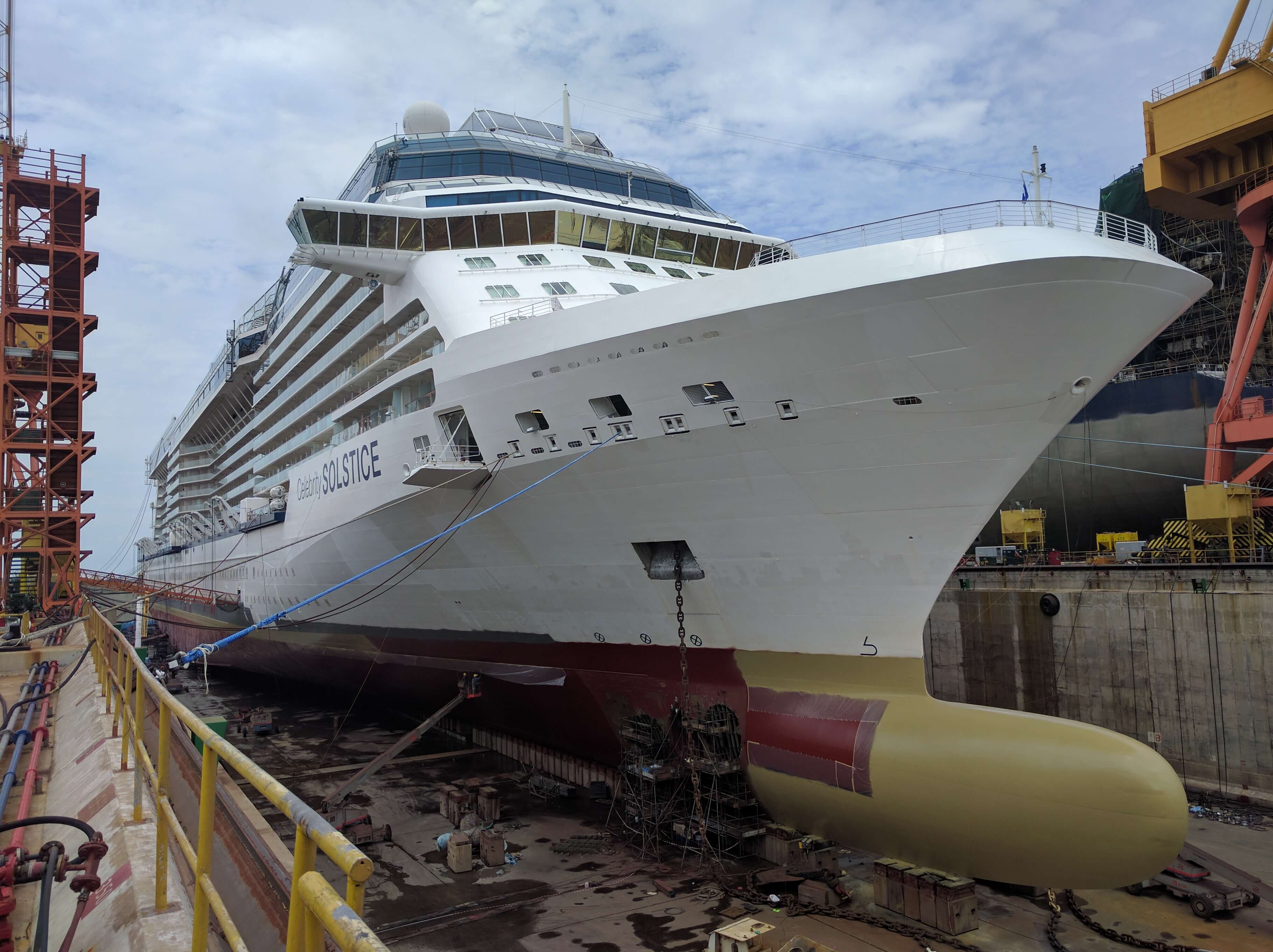
As you stand aboard a grand cruise ship, captivated by its opulent amenities and the vast seascape, it’s easy to forget the marvel that lies submerged beneath the waterline.
This crucial part of the ship, often overshadowed by its above-deck counterparts, plays a foundational role in ensuring performance, safety, and sustainability.
Delving into the intricacies of a cruise ship’s underside offers insights into the world of naval architecture, dispelling myths and revealing the innovations that guarantee our voyages are not only enjoyable but also safe.
Let’s embark on a deep dive into the unseen hero that keeps these magnificent vessels afloat.
What Is the Bottom of a Cruise Ship Called?
For those unfamiliar with naval terminology, deciphering the various parts of a ship can seem like navigating through a linguistic maze.
When it comes to cruise ships, or any seafaring vessel, the ‘bottom’ has its own special designation, deeply entrenched in shipbuilding traditions and maritime lore.
The bottom of a cruise ship is commonly referred to as the “hull.” The hull is the watertight body of the ship, extending from the main deck to the very base.
It is integral to buoyancy, stability, and the overall structural framework of the vessel.
Built to counteract water pressure, stave off corrosion, and facilitate smooth sailing, the hull’s design and materials are specifically tailored for maritime conditions.
Within the hull, there are distinct subdivisions:
Often regarded as the ship’s backbone, the keel runs centrally from the front to the back at the very bottom. It grants the ship its structural strength and is paramount for stability.
Situated at the lowest part of the ship’s hull, the bilge is where water typically accumulates due to various factors like condensation, potential leaks, or specific onboard activities.
Ships are equipped with bilge pumps designed to expel this water, ensuring the vessel remains dry and secure.
A protrusion at the front bottom of many modern ships, including cruise ships. This unique design helps reduce resistance as the ship moves through water, increasing fuel efficiency and speed.
It also aids in reducing the bow waves, making voyages smoother for passengers.
Over the centuries, the design and nuances of the hull have continually evolved, reflecting advancements in technology and the distinct requirements of diverse ship categories.
In the context of cruise ships, the hull stands out as especially vital, safeguarding the journey of thousands of passengers and crew members as they traverse the vast oceans.
To sum up, while the phrase ‘bottom of a ship’ may sound elementary, it unfolds a universe of design, engineering, and maritime heritage in the embodiment of the hull. It showcases mankind’s remarkable capacity to innovate and master the challenges of the deep blue.
What Does the Bottom of Cruise Ships Look Like?
The exterior of cruise ships, with their towering decks and panoramic windows, often captures the imagination of spectators. Yet, the underwater portion, though unseen by most passengers, is an engineering marvel in its own right.
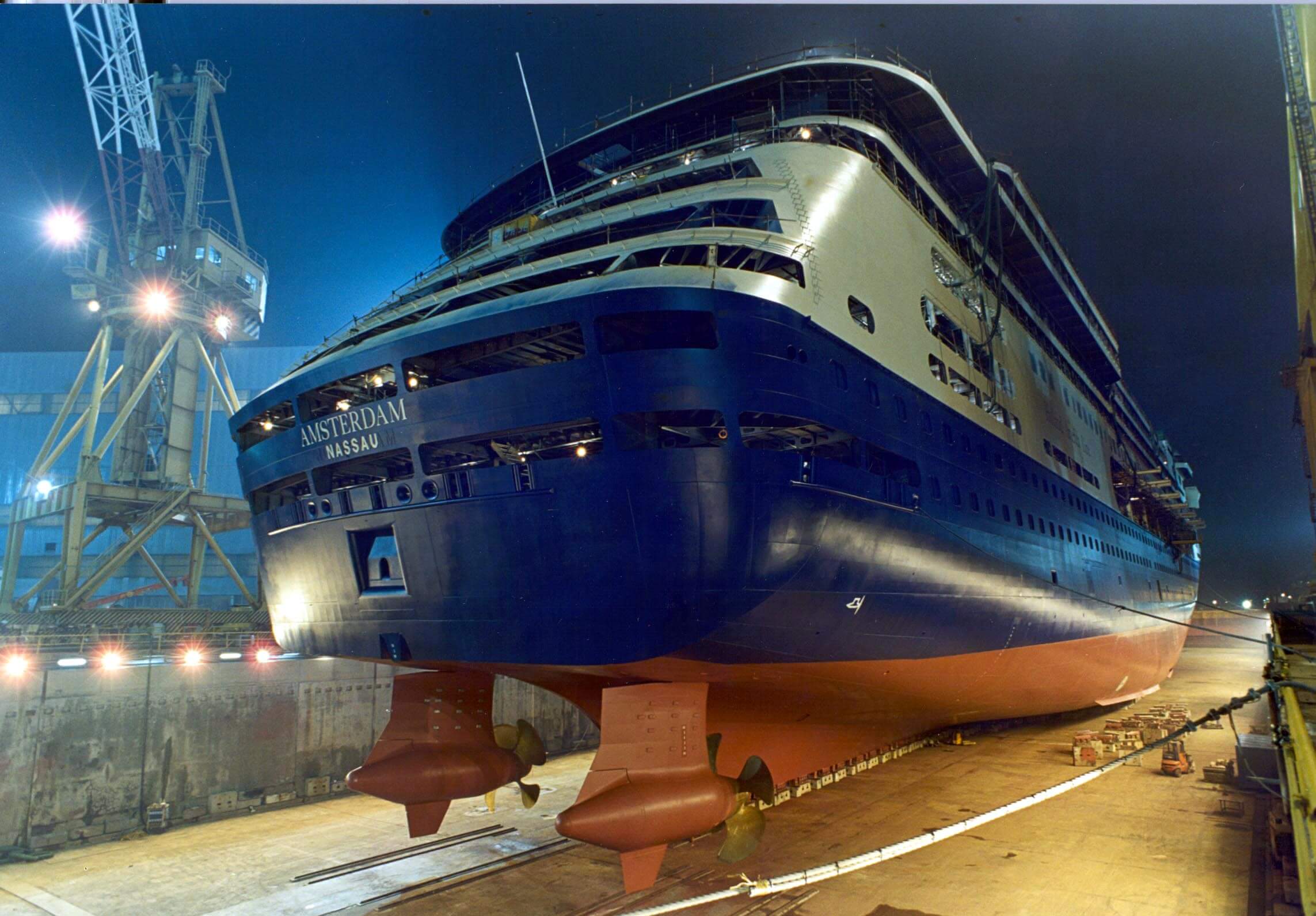
Image credit: Bolici
So, what does it look like underneath a cruise ship?
Shape and Structure
The underbelly of a cruise ship is streamlined and sleek, designed for efficient movement through water. While the top of the ship might have multiple decks and superstructures, the bottom narrows down to a smooth, somewhat flat surface, tapering towards the stern and bow.
Material and Color
Typically made of robust steel, the hull has a thickness that can handle the immense pressures of the sea. It is often coated with a specialized paint known as anti-fouling paint.
This unique paint, usually dark in color (like blue or black), prevents marine organisms like barnacles and algae from attaching to the ship, ensuring smoother movement and better fuel efficiency.
Bulbous Bow
As previously mentioned, many modern cruise ships have a bulbous protrusion at the front bottom. This rounded extension is easily identifiable and plays a pivotal role in enhancing the ship’s hydrodynamics.
Rudders and Propellers
Towards the stern of the ship, one can find the ship’s rudders and propellers. These critical components steer the ship and provide thrust, respectively. They are massive in size, with some cruise ship propellers spanning several meters in diameter.
Stabilizers
Extending from the sides of the hull are stabilizer fins, similar in appearance to airplane wings but submerged. They help counteract the ship’s roll, ensuring a more stable and comfortable journey for passengers.
Sensors and Equipment
The hull might house various sensors, like sonar, which assist in navigation and detecting underwater obstacles. These devices are often recessed or streamlined to maintain the smooth contour of the ship’s underside.
Keel and Bilge
Right at the center and deepest part of the bottom, the keel runs longitudinally, acting as the ship’s backbone. The bilge, a slightly curved section, is where water collects and is expelled by bilge pumps.
In essence, the bottom of a cruise ship is a fusion of form and function, showcasing advanced engineering tailored for the unique demands of maritime travel.
It’s an intricate balance of design elements, all working in harmony to navigate the complexities of the ocean and provide passengers with unforgettable voyages.
How Far Underwater Is The Bottom Of A Cruise Ship?
One of the marvels of maritime engineering is the ability to float structures weighing several tons effortlessly on water. Cruise ships, often referred to as “floating cities” due to their vastness, are a prime example.
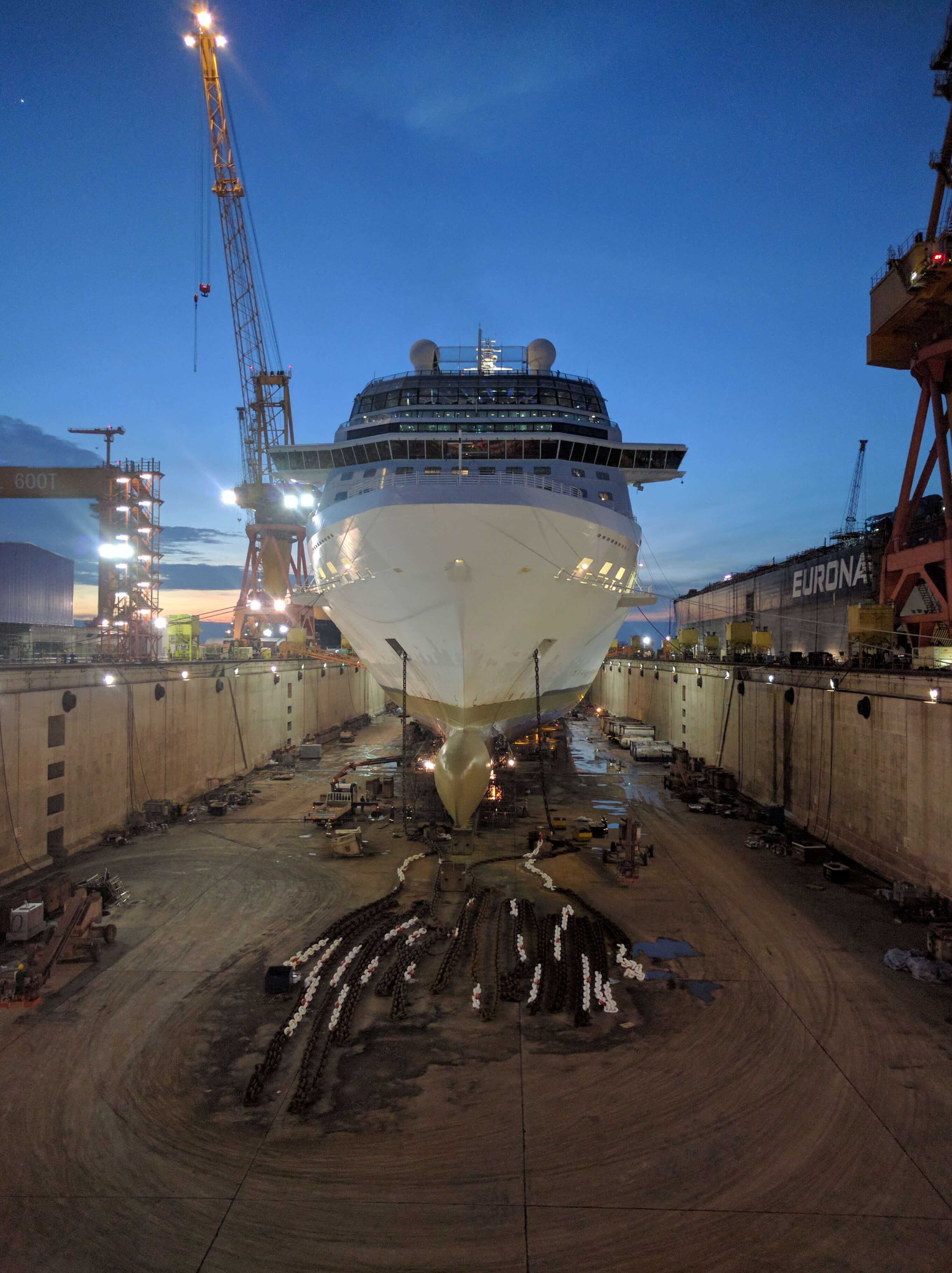
But just how deep does the bottom of such a vessel sit underwater? This submerged portion of the ship is technically termed its “draft.” Here’s an exploration of that aspect
Understanding Draft
The draft of a ship refers to the vertical distance between the waterline and the lowest point of the vessel’s keel. In simple terms, it indicates how much of the ship is underwater
Factors Influencing the Draft
Ship’s load.
As a ship takes on more weight, be it cargo, fuel, provisions, or passengers, it will sit deeper in the water, increasing its draft.
Water Density
Saltwater is denser than freshwater. So, a ship will sit slightly higher (have a shallower draft) in the ocean compared to a freshwater lake or river, all else being equal.
Temperature and Salinity
Variations in water temperature and salinity can influence its density, subsequently affecting the ship’s draft.
Typical Draft of a Cruise Ship
Cruise ships vary in size, from smaller luxury vessels to mega-ships. The draft can range considerably based on this:
Smaller Cruise Ships
They might have a draft ranging from 20 to 25 feet (6 to 7.6 meters).
Medium to Large Cruise Ships
These can have drafts anywhere from 25 to 30 feet (7.6 to 9.1 meters).
Mega Cruise Ships
The largest of cruise ships can have drafts exceeding 30 feet (9.1 meters), with some even approaching 40 feet (12.2 meters).
Operational Considerations
Navigating shallow waters.
Cruise ships sometimes need to access ports located in shallower waters. In such cases, having a shallower draft is beneficial. Some ships are specially designed with this in mind to expand their potential itineraries.
Ballast Systems
Modern cruise ships are equipped with ballast systems that can adjust the amount of water they carry, thereby influencing their draft to some degree, helping in optimizing stability and navigating varying water depths.
Safety Margins
While understanding the draft is essential for navigation, ships also maintain safety margins. This ensures that they don’t accidentally scrape the seabed when navigating areas close to their maximum draft.
In essence, the portion of a cruise ship that’s submerged underwater is influenced by a variety of factors, both inherent to the ship’s design and external conditions.
While passengers aboard enjoy the panoramic views and luxurious amenities, the depth at which the ship’s bottom sits plays a pivotal role in its safe and efficient navigation.
Are Cruise Ship Bottoms Flat?
The design and structure of cruise ships are fascinating topics of exploration, and a common question that arises is regarding the shape of their bottoms.
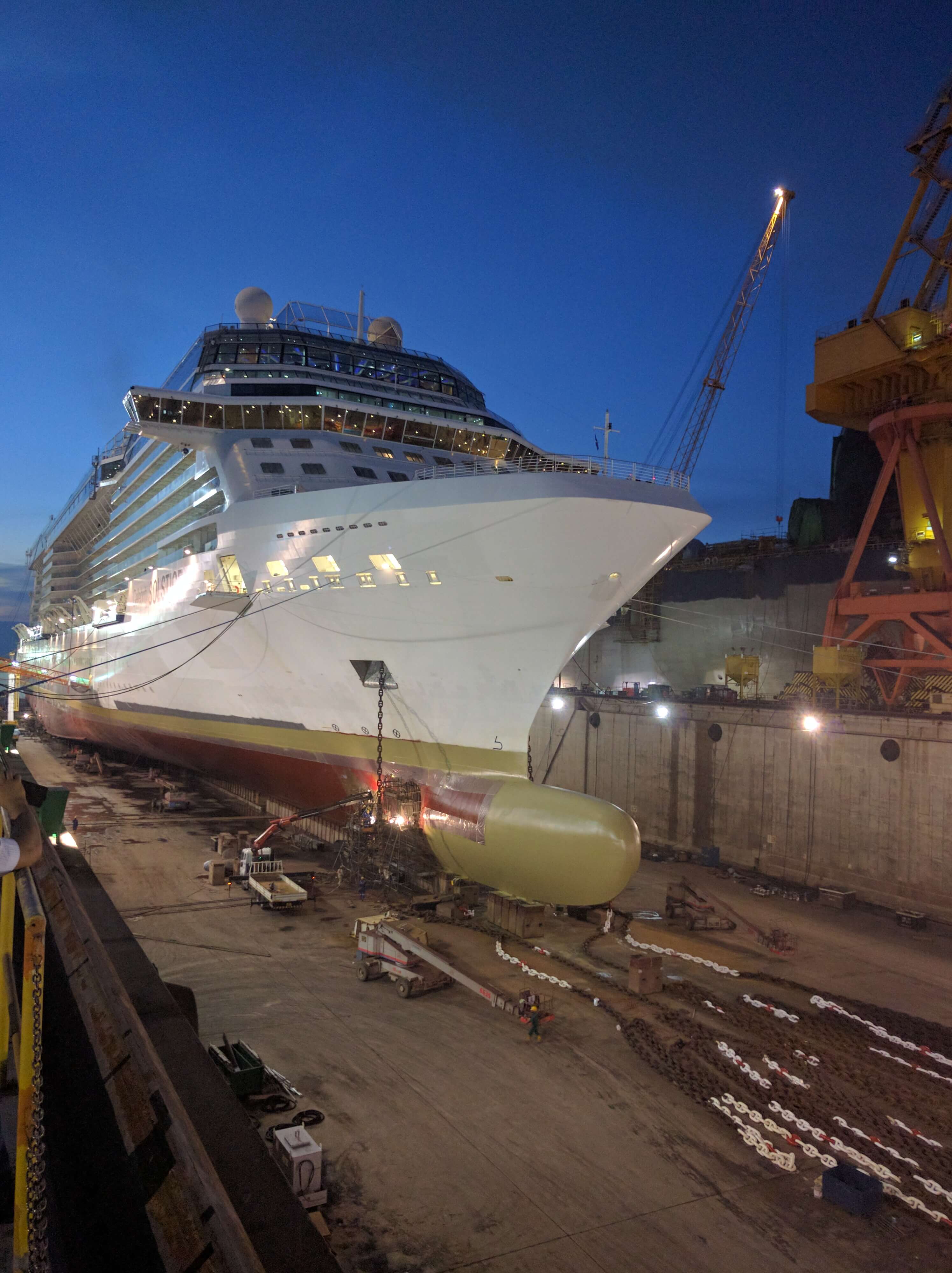
Are they flat, as one might presume when considering the massive size and weight of these vessels?
Let’s have a look:
General Design
At first glance, one might assume that the large, broad base of a cruise ship would be flat to maximize stability. However, the reality is more intricate.
Cruise ship bottoms are not entirely flat; they have a somewhat curved design, especially noticeable from the bow to the stern.
Why Not Completely Flat?
Several reasons dictate the non-flat design
Hydrodynamics
A completely flat bottom could create more resistance as the ship moves through the water. A slightly curved design allows for smoother passage, reducing drag and improving fuel efficiency.
Buoyancy and Stability
The curved design distributes the ship’s weight more evenly, allowing it to float and move with more balance, especially in rough seas.
Dealing with Depths
A slightly raised or curved design in certain parts of the bottom ensures the ship doesn’t run too deep, especially helpful when navigating shallower waters or ports.
Considerations in Modern Shipbuilding
As cruise ship designs evolve, so do the considerations for their hull shape. Environmental concerns, fuel efficiency, passenger comfort (minimizing motion sickness), and navigational needs all play roles in determining the precise curvature and features of a ship’s bottom.
Basically, while cruise ships might appear to have a vast, flat base given their immense size, their bottoms are not strictly flat.
They are designed with a subtle curvature and specific features that cater to the complex demands of maritime engineering, ensuring efficient, safe, and comfortable voyages for all on board.
Why is the Bottom of a Ship Painted Red?
The distinctive red color often seen painted on the bottom of ships, both historic and contemporary, is more than just an aesthetic choice.
This age-old tradition has a foundation in practicality, functionality, and maritime science. Here’s a closer look at why ships frequently don this fiery hue below the waterline:
Historical Use of Copper
In the age of wooden ships, sailors discovered that sheets of copper or copper-based paint on a ship’s hull would prevent marine organisms like barnacles and teredo worms from boring into the wood and damaging it. Copper, when in contact with seawater, releases ions that have anti-fouling properties.
The characteristic reddish-brown color of oxidized copper led to a distinct red hue on the ship’s bottom.
Anti-fouling Paint
Marine organisms attaching to the hull – known as fouling – significantly impact a ship’s performance and durability. It can increase drag, reduce speed, and lead to higher fuel consumption.
Modern anti-fouling paints, which are successors to the original copper sheathing method, often still contain cuprous compounds. While there are varying colors available today, the traditional red remains a popular choice due to its historic ties.
Visibility of Damage and Fouling
Red offers a stark contrast to the deep blues and greens of ocean waters. This contrast makes it easier for sailors and dock workers to spot damages, leaks, or excessive fouling on the ship’s hull.
Tradition and Aesthetics
Over time, the red bottom became a maritime tradition. Even with the evolution of marine paints and coatings, many ship owners and builders still prefer the classic red for its aesthetic appeal and nod to seafaring heritage.
Economical and Practical
Red pigments were historically more affordable and abundant, making them a cost-effective choice for shipbuilders and owners.
Variations in Hue
It’s worth noting that while red is common, it’s not universal. Different shades ranging from brownish-red to pink or even other colors like black and blue can sometimes be observed.
These choices can be influenced by the specific anti-fouling product used, company branding, or other functional considerations.
In summary, the red bottom of ships is a marriage of practicality and tradition. While it has its roots in the bygone era of wooden vessels and copper sheathing, the color persists today as a symbol of maritime legacy, aided by the practical benefits it continues to offer in the modern age.
How Do You Clean the Bottom of a Cruise Ship?
Ensuring the hull of a cruise ship is clean is not just an aesthetic concern; it’s crucial for the vessel’s efficiency, safety, and environmental footprint.
Over time, marine organisms, such as barnacles, algae, and mussels, can attach themselves to the ship’s bottom. This phenomenon, known as biofouling, can slow the ship down, increase fuel consumption, and even damage the hull.
So, how do cruise lines keep these gigantic vessels in pristine condition beneath the waterline?
Dry Docking
This is the most comprehensive method for cleaning and maintaining the hull. Every few years, cruise ships are scheduled for dry docking. During this process, the entire vessel is taken out of the water, allowing workers to access and clean the ship’s bottom thoroughly.
This is also an opportunity to inspect the hull for damages, repaint it with anti-fouling paint, and conduct any other necessary repairs or upgrades.
Underwater Cleaning Robots
With advancements in technology, some cruise lines employ automated underwater robots or remotely operated vehicles (ROVs) equipped with brushes and cameras.
These devices can scrub the hull’s surface while the ship is still in the water, removing accumulated organisms and grime.
For specific tasks, or when robots might not be feasible, trained divers are deployed. They manually clean and inspect the hull using specialized tools. This method is particularly useful for addressing localized issues or conducting minor repairs.
Anti-fouling Coatings
One preventive measure against biofouling is the application of anti-fouling paint. These coatings release biocides, substances that deter marine organisms from attaching to the hull.
The paint not only provides a smoother surface, reducing drag and enhancing fuel efficiency, but also minimizes the need for frequent cleanings.
Ultrasonic Systems
Some modern ships are equipped with ultrasonic anti-fouling systems. These use ultrasonic waves to prevent marine growth on the hull.
The vibrations create an environment that’s unfavorable for organisms, thereby preventing them from settling on the ship’s bottom
Eco-friendly Solutions
With growing environmental concerns, the maritime industry is continuously exploring eco-friendly solutions for hull cleaning. Techniques that don’t rely on harmful chemicals and that cause minimal disruption to marine ecosystems are being prioritized.
Maintaining the cleanliness of a cruise ship’s bottom is an ongoing task that combines manual efforts, technological solutions, and preventive measures.
The commitment to keeping these colossal vessels clean underscores the importance of efficiency, safety, and environmental responsibility in the cruise industry.
What is in the Bottom of a Cruise Ship?
While the vast decks and luxurious amenities are what usually capture the attention of cruise-goers, the bottom levels, often hidden from the guests’ view, play a pivotal role in ensuring the smooth operation of the entire vessel.
These areas, which make up the foundational layers of the ship, are both functional and crucial for safety. So, what exactly can one find in the bottom of a cruise ship?
Engine Rooms
Typically situated deep within the ship, the engine rooms house the primary machinery that powers the cruise ship. From massive diesel engines to electrical systems, this is where the ship’s heartbeat resides.
Large tanks containing the fuel needed to power the ship’s engines are usually located towards the bottom. Their placement helps in maintaining the ship’s balance and stability.
Ballast Tanks
Ballast tanks play a vital role in maintaining a ship’s stability. They can be filled or emptied of water to adjust the ship’s weight and balance. This is particularly useful when accommodating changes in fuel weight or cargo distribution.
As mentioned earlier, the bilge is the lowest point of the ship where water, from sources like condensation or minor leaks, collects. Bilge pumps are stationed here to expel this water and ensure the ship remains dry.
Stabilizers’ Machinery
While the actual stabilizers are external and protrude from the sides of the ship, the mechanisms and controls that operate them are located within the lower levels.
Waste Treatment Facilities
Modern cruise ships are equipped with advanced waste treatment systems that handle and process sewage, gray water, and other waste products. This ensures environmental regulations are met and minimizes pollution.
Storage Areas
The bottom levels often contain vast storage rooms. These are crucial for storing provisions, from food and drink to spare parts and other essential supplies needed for long voyages
Crew Quarters
While crew members reside throughout the ship, some crew quarters, especially for those working in the engine rooms or other lower-deck service areas, might be located towards the ship’s bottom.
Laundry Facilities
Given the number of guests and the volume of linens, towels, and uniforms, cruise ships require extensive laundry facilities. Some of these operations are located in the lower decks due to space requirements and logistical convenience.
Water Tight Compartments
For safety, the bottom of the ship contains several watertight compartments. In the event of a breach or flooding, these compartments can be sealed off to prevent water from spreading and compromising the ship’s buoyancy and stability.
In essence, the bottom of a cruise ship is a bustling hub of crucial operations and facilities, all working seamlessly behind the scenes.
These layers ensure that guests above can enjoy their journey with peace of mind, blissfully unaware of the intricate dance of engineering and logistics taking place below their feet.
Videos Underneath a Cruise Ship
Here’s an interesting video of a guy dropping a gopro underneath a cruise ship…
And here’s a video of a cruise ship in drydock:
To Sum It Up
The bottom of a cruise ship, often overshadowed by the vessel’s towering decks and luxurious amenities, holds a rich tapestry of engineering, history, and maritime tradition.
From the precise design of the hull to ensure hydrodynamic efficiency and stability, to the depths at which these massive ships sit in the water, and the distinctive red hue that has colored the undersides of vessels for centuries, each aspect serves a purpose rooted in functionality and heritage
. The red paint, in particular, is a vivid testament to the blending of past maritime practices with contemporary needs, symbolizing the enduring spirit of naval exploration and adventure.
As passengers sail to their next destination, they’re buoyed by a legacy of seafaring innovation and tradition that lies beneath them, ensuring every voyage is safe, efficient, and in harmony with the vast oceans that cradle these magnificent vessels.
More Reading...
- Best Travel Gifts
- Best Travel Humidors
- Can I Bring A Fan On A Cruise Ship?
- Best Binoculars For Alaska Cruise
- Best Adventure Travel Blogs
- 14 Best Walkie-Talkies For Cruise Ships
Dan Claydon

What is a Bow of a Boat? Types of Bow Designs
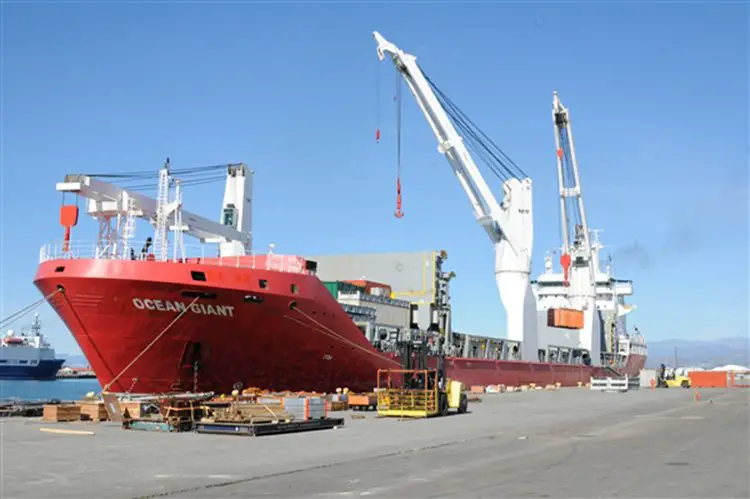
We will discuss a very important part of a ship or a boat – Bow .
Ships and boats face immense resistance on the water for the simple fact that compared to air, water produces more drag when moved through.
Hence the ships need to be designed in such a manner that the resistance is kept to the minimum. While conceptualizing a ship, the bow designs are the main factors.
While ships that are slender and curvier have less Wave Making Resistance while on the other hand, for the fuller ships the components of Wave Breaking Resistance are a more important factor.
What is the Bow of a Boat?
The bow is the name for the forward ends of the hull on boats and ships. It is the opposite end from the stern. The bow is that part of the ship that comes in contact with the water first and can be designed in a manner to control how the waves interact with the ship.
Where is the Bow of a Boat?
The bow is located in the front of a boat or ship. The bow of a boat usually has a pointed shape extending out of the water to cut through waves. This is designed to reduce drag and allow smoother movement through the water.
Types of Bow Designs
Though new designs seem to be dropping in every now and then, they seem to have reached a saturation point as most of them seem to be improvements made on old designs. With all that kept aside, here are some bow design types:
- The bulbous bow
- A normal bow without a bulb
- Other special bows
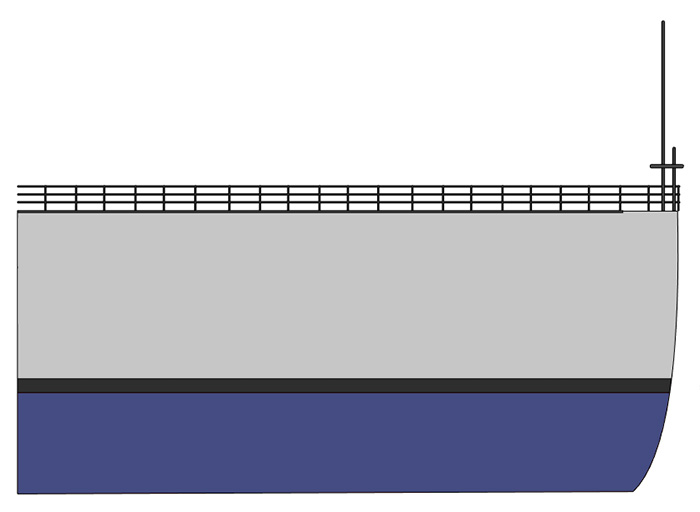
What we today call a normal bow has evolved from what was previously a vertical bow . Rake may be defined as the angle the ship’s stem makes with the waterline. This bow has the maximum waterline length of all.
A straight-edged vertical bow that is perpendicular to the waters is known as a plumb bow . If we don’t include an X-bow or Inverted bow, they happened to have the maximum waterline. This is what enables it to attain greater hull speed.
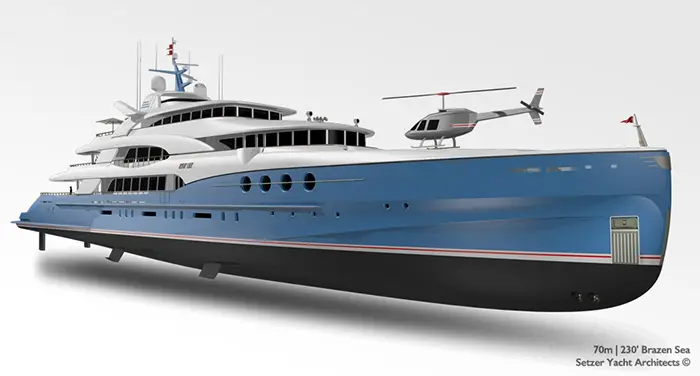
Pic courtesy: http://www.setzerdesign.com/new-concepts/plumb-bow-superyachts
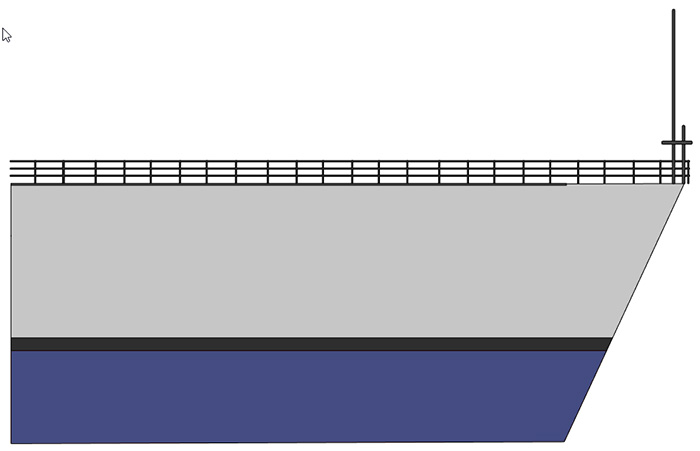
Raked bow designs can be said to be the most commonly used bow. It is also the most popularly used. The line of the bow is flat. It does not have any curves. The acute angle has to be less than 45 degrees. This enables the forward waterline position to allow more accommodations and especially a larger forward stateroom V-berth.
Clipper Bow
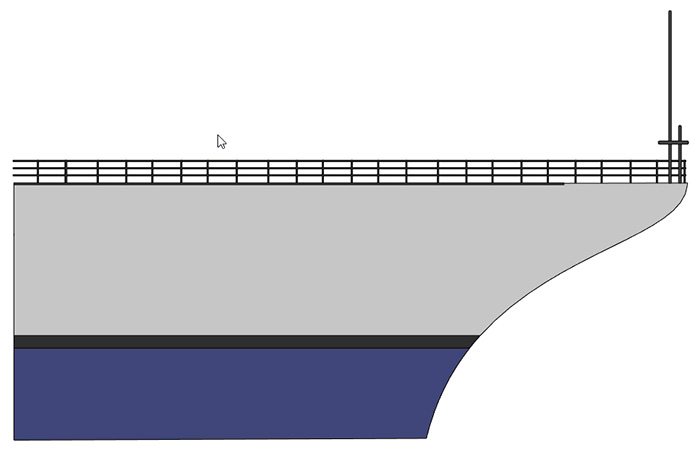
Clipper bow designs are some of the most traditional types of bow designs. The angle at which a ship’s hull plate or planking departs from the vertical in an outward direction with increasing height is known as a flare. They are used in conjunction with rakes.
Apart from easing the pitch motions flaring keeps water off the decks. Sometimes the rake is set up in such a manner that it protects the submerged portion during the collision by taking the impact first. This is known as the ‘crumple zone’.
In general, these types are called clippers . The way the rake is set up here increases the center of buoyancy as well as the stability of the ship. This, in turn, increases the GM which is an important factor for the ship’s stability.
Read more: What is a clipper ship?
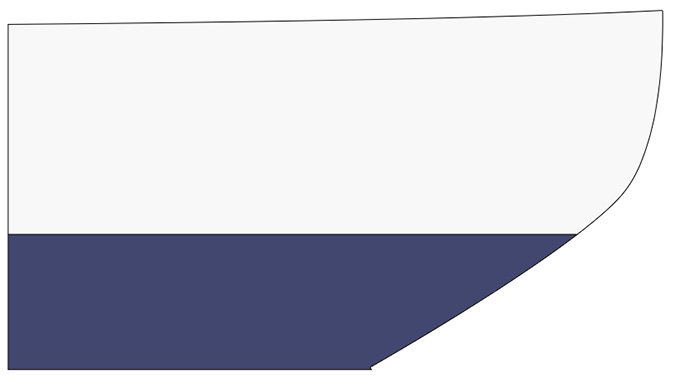
A spoon bow is a kind of bow design that convexes to the deck. It is called so because of its spoon-like appearance. This curve near the waterline is the most gradual. Such bow designs produce wave-making resistance due to the curvature at their cross-section.
Bulbous Bow

In bulbous bows, there is a protruding bulb at the bow just below the waterline. Here the water flows around the hull such that it reduces drag and increased fuel efficiency (up to 12% to 15% more than those ships that don’t have a bulbous bow), speed, range, and most importantly stability.
A bulbous bow increases the buoyancy of the front part and thereby decreases some of the up and down motion of the ship.
They are especially effective when the waterline length is longer than 15 meters and when the vessel is supposed to operate at its maximum speed most of the time. Such conditions are usually met by naval vessels, cargo ships, passenger ships, tankers, and supertaskers.
A bulbous bow would be detrimental to efficiency if used on smaller watercraft and thereby never used on powerboats, sailing boats , yachts, and other recreational boats.
The bulbous bow does its job by producing what is called the bow wave . The bulb forces the water up forming a trough and when added to a conventional bow in the right manner cancels out the wave produced by it, hence reducing the vessel’s wake.
A bulbous bow is popular in seagoing cargo ships and vessels that are larger in size.
Also read: What is a Hydrofoil Boat?
Parabolic and Cylindrical Bows
Compared to the straight sharp bow section ship designers sometimes tend to design blunt stems, thereby creating a parabolic shape. They are sometimes using in addition to bulbs to tackle the Wave Breaking Resistance. These bow designs are popular in bulk carriers of a fuller build.
Parabolic bows have a close resemblance to cylindrical ship bows since they are also designed keeping a bigger form factor in mind. They have the ability to absolutely minimize the Wave Making Resistance if proper care is taken while designing them. They are ideal for ships in fully loaded conditions.
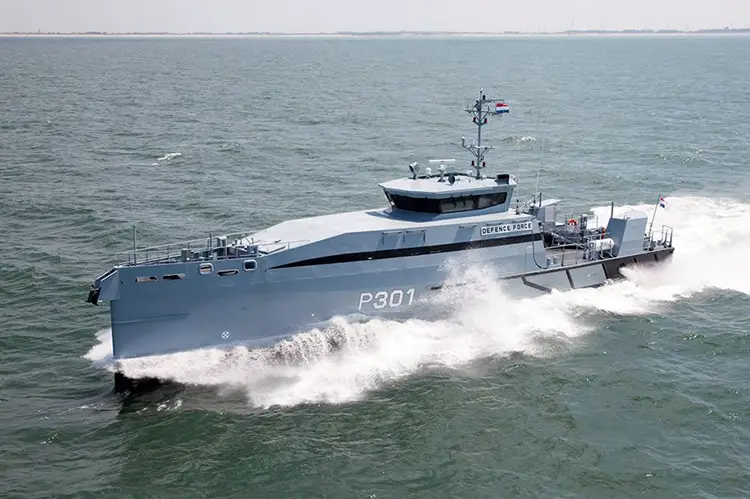
So, what is the job of an axe? To cut trees, right? The axe bow used in ships has a similar task too, that is cutting through the water. The long deep and narrow fore portion of the hull resembles an axe. The design includes a vertical stem line.
This shape allows the ship to easily pass through the waves and keeps the up and down motion of the ship to the minimum when compared to a normal bow. The lower portion of the fore-end of the hull is known as the forefoot. It remains submerged in the water and thus less open to slamming.
This has its disadvantages as well because a ship with an axe bow requires more power from the rudder while maneuvering.
Inverted Bow
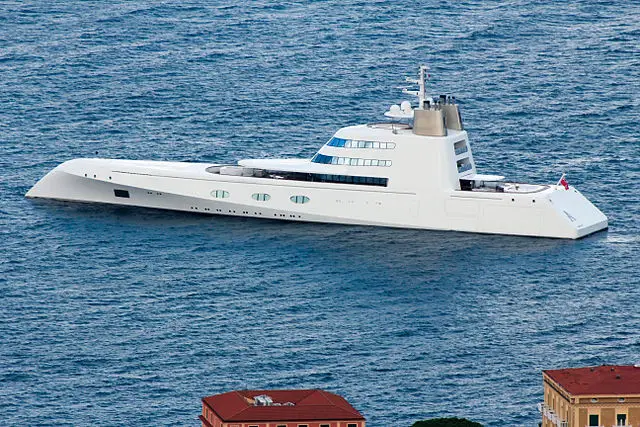
An inverted bow, often known as a reverse bow is referred to those in which the most extended point is not the top, but rather the bottom. They maximize the waterline, thereby resulting in tremendous hull speed and better hydrodynamic drag when compared to normal bows. To achieve that they sacrifice buoyancy and tend to dive under the waves instead of going above.
Just like the axe bow designs the pitching (up and down motion) and slamming are much reduced resulting in a much more enjoyable journey for the crew. They are quite operable in the medium tide and are easily maneuverable.
They are fuel-efficient too. Another positive aspect of the bow is that it doubles up like a deck and can accommodate the personnel.
Previously they were popular on battleships and large cruisers. But they became unpopular when newer designs came about. This was because they were not good at tackling high waves and became wet at high speed.
However, they have re-entered the market with all glory and are used nowadays mostly in AHTS (Anchor Handling Tug Supply) vessels, Seismic Vessels, Offshore and Pipelay Vessels, drillships, etc.
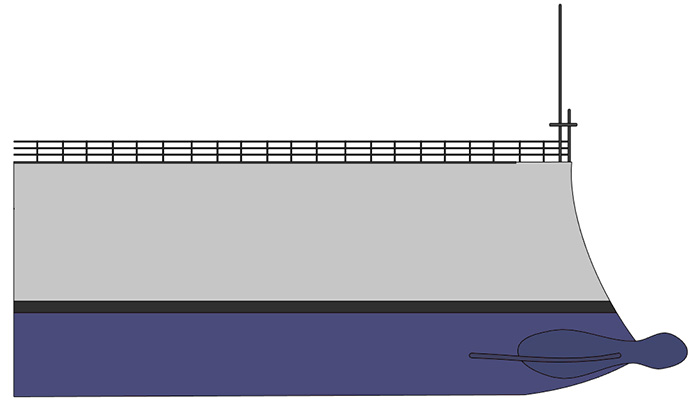
A ram bow is more of an extension that is built underwater below the hull of a ship. It is a kind of weapon which is used to pierce the hull of an enemy ship. It is not used much in today’s time but it was quite popular a few decades ago.
As we came to know earlier almost all possible combinations of bow designs have been attempted and so any bow that you come across must either be present in this list or would be the combination of the ones present here.
Similar Posts
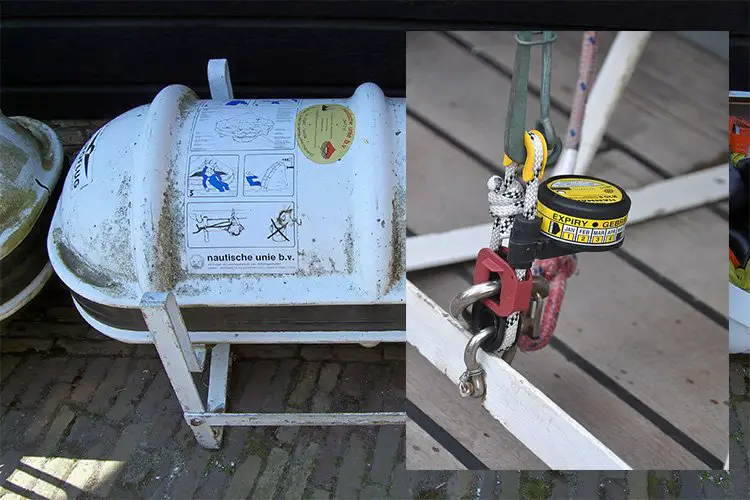
Hydrostatic Release Unit: A Complete Guide
A Hydrostatic Release Unit (HRU) is a pressure-activated mechanism. It is designed to automatically deploy a life raft under certain pressure. In case a vessel sinks, the HRU will activate and release the life raft at a depth between 1,5 and 4 meters. The pressure of the water against a diaphragm within the sealed casing…
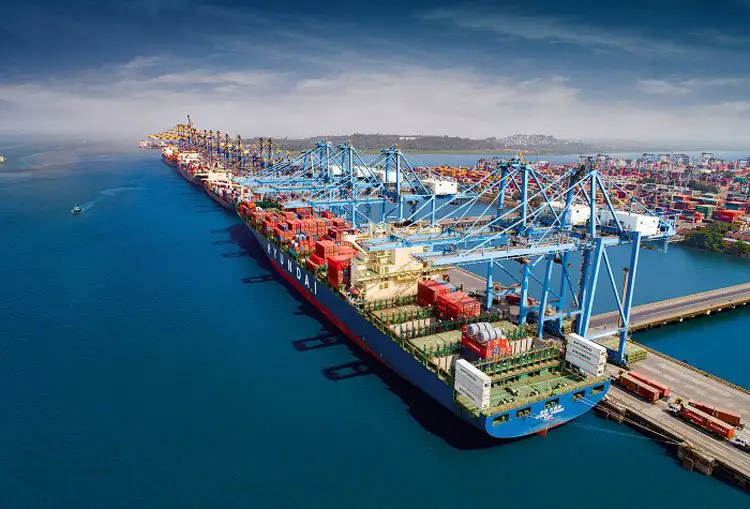
16 Biggest Ports in India
Before diving into the list of the major ports in India, let’s find out more about India’s sea trade activities and statistics. Introduction Kerala, Karnataka, Maharashtra, Goa, Gujarat, West Bengal, Odisha, Andhra Pradesh, and Tamil Nadu are the nine coastal states that makeup India. One of the biggest areas of land that juts out into…
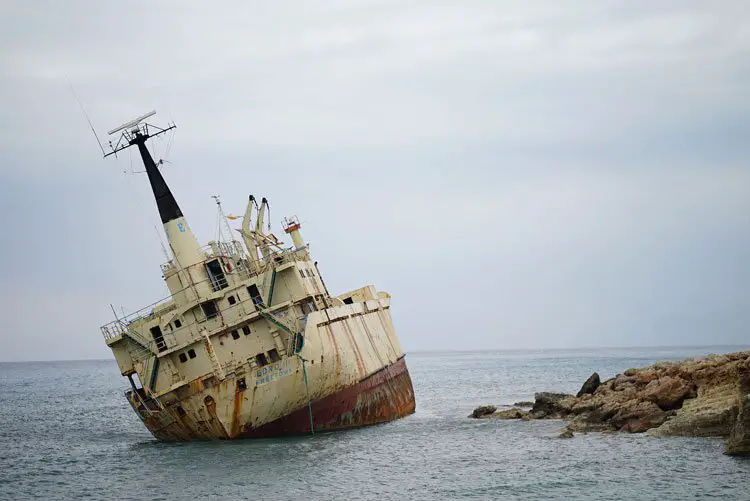
Capsizing and Reasons for Capsizing
What is Capsizing? Capsizing is a condition where the ship or the vessel turns to its one side or completely turns upside down in the water. Sometimes they can reverse to their original position, but most of the time ships either sink or have heavy damage. This is a dangerous situation for ship sailors, crew,…
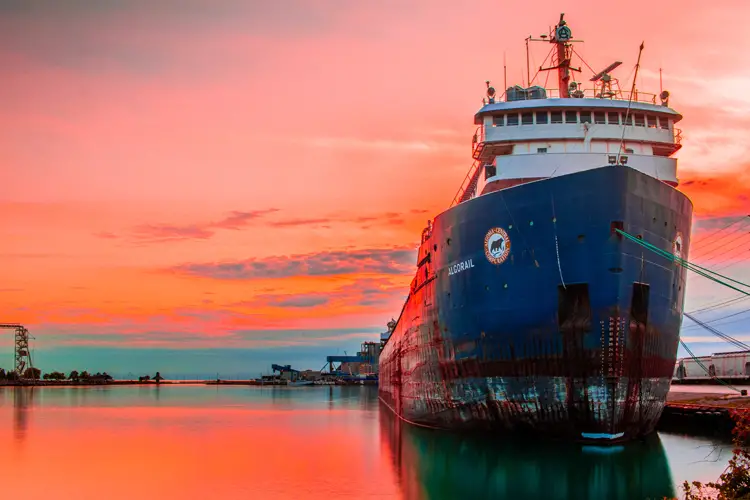
How Does the Corrosion Process Affect Ships?
Boats constantly interact with water, making them susceptible to damage at sea. While ship operators have numerous duties, watching for and preventing corrosion is high on the list. Corrosion causes ship parts to deteriorate over time, compromising the boat’s integrity and leaving occupants vulnerable to accidents. Longevity and efficiency are crucial for ships, considering today’s…
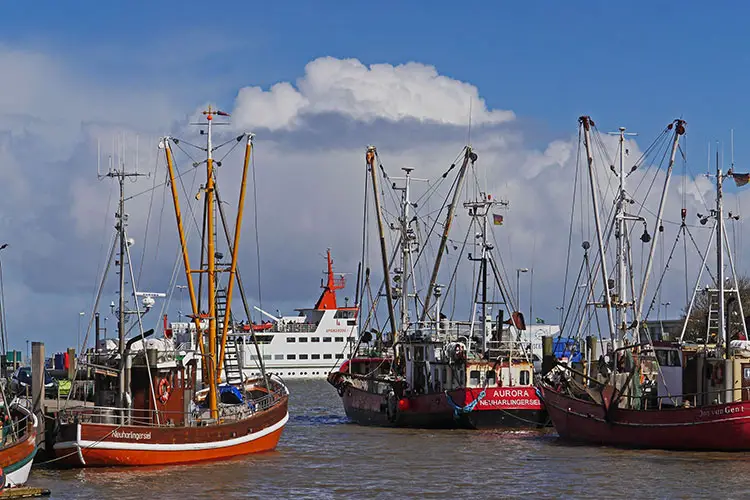
Vessel Monitoring System (VMS)
What Is A Vessel Monitoring System? A Vessel Monitoring System (VMS) is defined as a communication system used to monitor, control, and survey fishing activities, usually commercial. It is employed in almost every fishing vessel in the world today. This article discusses the importance of the vessel monitoring system as an easy and reliable way…
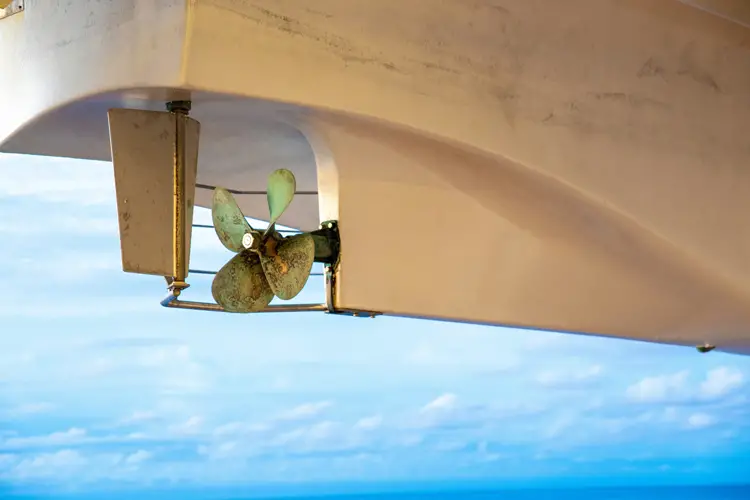
Skeg Guards: Are They Actually Worth It?
Almost every boat owner has heard of a Skeg guard and has participated in at least one debate on whether they are actually a good investment. Skeg guards are usually metal, plastic, or fabric covers that are designed to protect the skeg of your boat from damage and general wear and tear. In this article,…
What is the name of a measurement from the bow of the boat to the waterline.
I’d call it overhang
Leave a Reply Cancel reply
Your email address will not be published. Required fields are marked *
Save my name, email, and website in this browser for the next time I comment.
This website uses cookies to improve your experience. We'll assume you're ok with this, but you can opt-out if you wish. Read More


‘Vertical cruise ships’? Here’s how we can remake housing towers to be safer and better places to live
Postdoctoral Research Fellow, Transforming Housing Project, The University of Melbourne
Professor in Architecture and Director, Melbourne School of Design, The University of Melbourne
PhD Candidate and Research Assistant, Faculty of Architecture, Building and Planning, The University of Melbourne

Disclosure statement
Katrina Raynor receives funding from the University of Melbourne's Hallmark Research Initiative for Affordable Housing.
Alan Pert is Chair of The Hallmark Research Initiative for Affordable Housing at the University of Melbourne. Alan Pert is also Chair of 'IBA Melbourne'
Catherine Townsend receives funding from the University of Melbourne's Hallmark Research Initiative for Affordable Housing.
University of Melbourne provides funding as a founding partner of The Conversation AU.
View all partners
After 3,000 people in nine public housing towers in Melbourne were placed under the harshest coronavirus lockdown in Australia so far, acting Australian Chief Medical Officer Paul Kelly referred to the towers on July 5 as “ vertical cruise ships .” The statement was a reference to the danger of contagion in these overcrowded buildings. However, such terms play into a long, international history of vilifying public housing estates.
Legions of social housing towers, such as Pruitt Igoe in St Louis and the Gorbals Public Housing Estate in Glasgow , have been demolished since the early 1970s after being blamed for a wide range of social issues. But high density is not the problem. It is the way such buildings are designed, maintained and funded.
Blaming specific built forms distracts attention from decades of under-investment in social housing. The result has been tightly rationed , poorly insulated , deteriorating and overcrowded housing. Much of it is due for retrofitting or renewal.
Read more: Shh! Don't mention the public housing shortage. But no serious action on homelessness can ignore it
In this article we discuss successful, safe and sustainable models of retrofitting social housing blocks.
Are public housing towers obsolete?
Most high-rise public housing estates across Melbourne (and indeed internationally) were built during the “ golden age ” of public housing. This era began after the second world war and lasted until the 1970s. More than 60% of Victoria’s housing stock is over 35 years old . Much of it is in need of retrofit or renewal – it is impossible to ignore this looming requirement.
However, government responses thus far have been to allow the towers to quietly decay or to demolish towers while transferring public land to private ownership with nominal increases in social housing . One in five public housing tenants live in dwellings that do not meet acceptable standards in Australia.
Read more: The many faces of social housing – home to 1 in 10 Australians
An alternative to demolition
The Architects Journal of the United Kingdom is advocating retrofitting of ageing housing stock because of its many social, economic and environmental benefits. We agree with this in many cases.
The substantial embodied energy in a salvageable building makes its destruction environmentally wasteful. Re-use also reduces the social displacement that occurs with demolition. And when the full cost of demolition is calculated, Anne Power and others have shown retrofits are cost-effective.
The Grenfell Tower tragedy in 2017 put a spotlight on retrofit strategies. It exposed some of the broader tensions regarding repair and maintenance versus merely over-cladding to meet environmental targets or remove “eyesores” and aid neighbourhood gentrification .
Read more: We still live here: public housing tenants fight for their place in the city
3 shining examples of retrofits
Grand Parc Bordeaux
Grand Parc Bordeaux received the 2019 Mies van der Rohe Award , an annual European Union architecture prize. This transformation of three 1960s social housing blocks included the restoration and retrofitting of 530 apartments.
The project added deep winter gardens and open air balconies to the façade of each dwelling. Expansive glass sliding doors open from the apartments to the balconies.
Prefabrication of balcony modules enabled residents to stay in their apartments throughout construction. This approach avoided the large-scale displacement often associated with social housing renewal. The modules were crane-lifted into place, forming a free-standing structure in front of the housing block.
The retrofit also replaced lifts and renovated access halls.
DeFlat Kleiburg, Amsterdam
DeFlat Kleiburg by NL Architects and XVW Architectuur won the Mies van der Rohe Award in 2017 . This project is a retrofit of one of the largest housing blocks in the Netherlands, which was at risk of demolition.
The architects oversaw the refurbishment of the structure and communal areas. The project left an empty affordable shell for buyers to customise as they wished.
Park Hill Estate, Sheffield
In the United Kingdom, Sheffield City Council is undertaking a part-privatisation scheme with developer Urban Splash of the contentious Park Hill Estate . The late-1950s social housing blocks are being gutted to their concrete shells and new apartments developed within.
Architects Hawkins/Brown and urban designers Studio Egret West designed phase one. Mikhail Riches designed phase two, which is under way.
The project involves a significant change in tenure to a mix of one-third social to two-thirds private.

Read more: Public housing 'renewal' likely to drive shift to private renters, not owners, in Sydney
Public housing estates are part of a system
The above examples reflect architectural approaches to preserving brutalist architecture. However, architecture is just one part of any social housing response. In Australia, any retrofit or redevelopment should aim to retain or increase the amount of social housing, given the huge shortfall .
Vienna, Austria, has one of the most successful social housing systems in the world. Over 60% of the city’s population live in social housing and have strong tenancy rights. Robust funding mechanisms supply and maintain access to affordable and high-quality housing.
The government funds about a quarter to a third of all housing in Vienna each year – up to 15,000 apartments a year . Most subsidies are in the form of repayable, long-term, low-interest loans to build new housing. The decade-long operation of the system means repaid loans can be used to finance new construction, decreasing the budgetary burden.
A developer competition process was introduced in the 1990s to judge social housing bids. This means developers vie with each other to offer high-quality, energy-efficient homes.
For social housing to work, it must provide enough stock to meet housing needs. It must also receive enough funding to manage and maintain the housing.
Recent events have highlighted what multiple reports , commentaries and protest movements have been saying for years: Australia’s ageing social housing stock requires immediate attention. Australians need much more new social housing.
Read more: Australia needs to triple its social housing by 2036. This is the best way to do it
- Affordable housing
- Public housing
- Social housing
- Coronavirus
- Housing policy
- Urban renewal
- Housing design
- High-rise apartments
- high-rise living
- Melbourne outbreak
- Melbourne lockdown

Research Fellow

Senior Research Fellow - Women's Health Services

Lecturer / Senior Lecturer - Marketing

Assistant Editor - 1 year cadetship

Executive Dean, Faculty of Health
Sign up for our daily Newsletter and stay up to date with all the latest news!
You are receiving this pop-up because this is the first time you are visiting our site. If you keep getting this message, please enable cookies in your browser.
You are using software which is blocking our advertisements (adblocker).
As we provide the news for free, we are relying on revenues from our banners. So please disable your adblocker and reload the page to continue using this site. Thanks!
Click here for a guide on disabling your adblocker.
Growing vertical on a cruise ship
The 6,762-passenger MSC World Europa currently docked in Doha, Qatar, is introducing a new restaurant concept, branded the Chef's Garden Kitchen, which is a Babylon Micro-Farms powered hydroponic garden at sea with herbs, greens and garnishes grown onboard.

Alexander Olesen, Babylon Micro-Farms Founder and CEO, shared, "Growing fresh produce onboard a cruise ship that sails all around the world is a perfect illustration of Babylon's remote management technology. From our headquarters in Richmond, Virginia, we are able to deliver a safe, reliable, and convenient growing experience for Niklas Eksedt and his team. On-site Micro-Farms are going to be an important part of the supply chain for fresh ingredients, and it's exciting to push the boundaries of local food production with this world-first installation on the high seas. We are appreciative of MSC's confidence in Babylon, and our micro-farms and discussions are already taking place about the rollout of additional MSC ships that are currently under construction."

Michelin-starred chef, TV personality, and author Niklas Ekstedt has collaborated with MSC Cruises to design the menu for the specialty restaurant Chef's Garden Kitchen, focusing on natural ingredients and a farm-to-ocean ethos.
Born in Sweden, the son of a produce seller, Niklas Ekstedt began his strong connection with nature and the Earth's flavors at a young age. This new restaurant will feature the first-at-sea hydroponic micro-farm in the world, and guests will be treated to a uniquely immersive experience with the master chef preparing Ekstedt's extraordinary creations in an open kitchen against a backdrop of panoramic sea views.

Related Articles

Damian Ikemann appointed Managing Director of Klasmann-Deilmann

Singapore: I.F.F.I closes vertical farm and Sky Greens downsizes

Tami Van Gaal promoted to director of sales at Griffin

UK vertical farm celebrates success of conservation project

Denmark: 67% growth in the first quarter of 2024

US: New partnership to boost hybrid farming projects

Second hand growing equipment and container farms: a sustainable choice

Tecogen acquires balance of plant service contracts in Canada

Elektravon-Haket continues as Haket

Firm plans to raise $10k to develop power facility for indoor farms
Latest photo reports → see more.

Indoor AgCon 2024

Fruit Logistica - Vertical farming- and horticulture suppliers

A visit to VAXA, Iceland

Vertical Farming World Congress, London '23
share this!
July 15, 2020
'Vertical cruise ships'? Here's how we can remake housing towers to be safer and better places to live
by Katrina Raynor, Alan Pert and Catherine Townsend, The Conversation
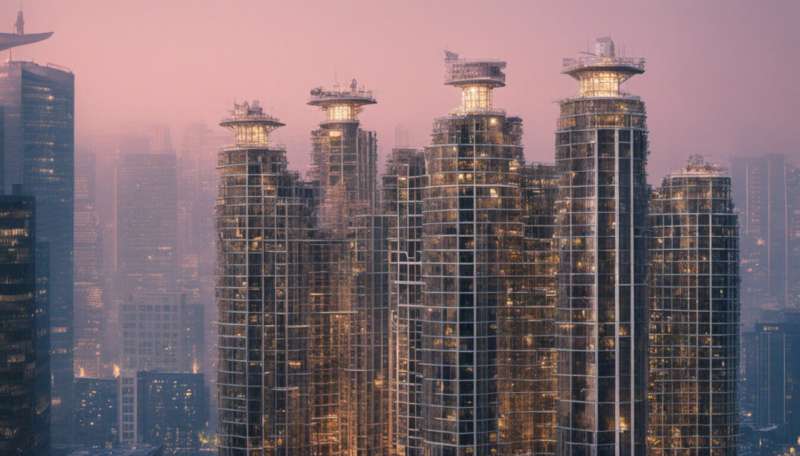
After 3,000 people in nine public housing towers in Melbourne were placed under the harshest coronavirus lockdown in Australia so far, acting Australian Chief Medical Officer Paul Kelly referred to the towers on July 5 as " vertical cruise ships ." The statement was a reference to the danger of contagion in these overcrowded buildings. However, such terms play into a long, international history of vilifying public housing estates.
Legions of social housing towers, such as Pruitt Igoe in St Louis and the Gorbals Public Housing Estate in Glasgow , have been demolished since the early 1970s after being blamed for a wide range of social issues. But high density is not the problem. It is the way such buildings are designed, maintained and funded.
Blaming specific built forms distracts attention from decades of under-investment in social housing. The result has been tightly rationed, poorly insulated, deteriorating and overcrowded housing. Much of it is due for retrofitting or renewal.
In this article we discuss successful, safe and sustainable models of retrofitting social housing blocks.
Are public housing towers obsolete?
Most high-rise public housing estates across Melbourne (and indeed internationally) were built during the " golden age " of public housing. This era began after the second world war and lasted until the 1970s. More than 60% of Victoria's housing stock is over 35 years old . Much of it is in need of retrofit or renewal—it is impossible to ignore this looming requirement.
However, government responses thus far have been to allow the towers to quietly decay or to demolish towers while transferring public land to private ownership with nominal increases in social housing . One in five public housing tenants live in dwellings that do not meet acceptable standards in Australia.
An alternative to demolition
The Architects Journal of the United Kingdom is advocating retrofitting of ageing housing stock because of its many social, economic and environmental benefits. We agree with this in many cases.
The substantial embodied energy in a salvageable building makes its destruction environmentally wasteful. Re-use also reduces the social displacement that occurs with demolition. And when the full cost of demolition is calculated, Anne Power and others have shown retrofits are cost-effective.
The Grenfell Tower tragedy in 2017 put a spotlight on retrofit strategies. It exposed some of the broader tensions regarding repair and maintenance versus merely over-cladding to meet environmental targets or remove "eyesores" and aid neighbourhood gentrification.
3 shining examples of retrofits
Grand Parc Bordeaux
Grand Parc Bordeaux received the 2019 Mies van der Rohe Award , an annual European Union architecture prize. This transformation of three 1960s social housing blocks included the restoration and retrofitting of 530 apartments.
The project added deep winter gardens and open air balconies to the façade of each dwelling. Expansive glass sliding doors open from the apartments to the balconies.
Prefabrication of balcony modules enabled residents to stay in their apartments throughout construction. This approach avoided the large-scale displacement often associated with social housing renewal. The modules were crane-lifted into place, forming a free-standing structure in front of the housing block.
The retrofit also replaced lifts and renovated access halls.
DeFlat Kleiburg, Amsterdam
DeFlat Kleiburg by NL Architects and XVW Architectuur won the Mies van der Rohe Award in 2017 . This project is a retrofit of one of the largest housing blocks in the Netherlands, which was at risk of demolition.
The architects oversaw the refurbishment of the structure and communal areas. The project left an empty affordable shell for buyers to customise as they wished.
Park Hill Estate, Sheffield
In the United Kingdom, Sheffield City Council is undertaking a part-privatisation scheme with developer Urban Splash of the contentious Park Hill Estate . The late-1950s social housing blocks are being gutted to their concrete shells and new apartments developed within.
Architects Hawkins/Brown and urban designers Studio Egret West designed phase one. Mikhail Riches designed phase two, which is under way.
The project involves a significant change in tenure to a mix of one-third social to two-thirds private.
Public housing estates are part of a system
The above examples reflect architectural approaches to preserving brutalist architecture. However, architecture is just one part of any social housing response. In Australia, any retrofit or redevelopment should aim to retain or increase the amount of social housing, given the huge shortfall .
Vienna, Austria, has one of the most successful social housing systems in the world. Over 60% of the city's population live in social housing and have strong tenancy rights. Robust funding mechanisms supply and maintain access to affordable and high-quality housing.
The government funds about a quarter to a third of all housing in Vienna each year – up to 15,000 apartments a year . Most subsidies are in the form of repayable, long-term, low-interest loans to build new housing. The decade-long operation of the system means repaid loans can be used to finance new construction, decreasing the budgetary burden.
A developer competition process was introduced in the 1990s to judge social housing bids. This means developers vie with each other to offer high-quality, energy-efficient homes.
For social housing to work, it must provide enough stock to meet housing needs. It must also receive enough funding to manage and maintain the housing.
Recent events have highlighted what multiple reports , commentaries and protest movements have been saying for years: Australia's ageing social housing stock requires immediate attention. Australians need much more new social housing .,
Provided by The Conversation
Explore further
Feedback to editors

Cultural and linguistic networks of central African hunter–gatherers have ancient origin, study finds
15 minutes ago

Study reveals promising technology for sepsis treatment using functional magnetic nanoclusters
17 minutes ago

From wild to domesticated: Scientists reveal 100,000 years of continuous rice evolution
20 minutes ago

Sloshing cold front detected in a massive galaxy cluster
38 minutes ago

Scientists discover polar Bloch points in strained ferroelectric films
50 minutes ago

Researchers create dispersion-assisted photodetector to decipher high-dimensional light

Rethinking the sun's cycles: New physical model reinforces planetary hypothesis

Researchers measure crystal nucleation in supercooled atomic liquids

Viper-mimicking snake from Asia is a unique branch in the reptile evolutionary tree

Scientists report unified framework for diverse aurorae across planets
Relevant physicsforums posts, music to lift your soul: 4 genres & honorable mention.
4 hours ago
Cover songs versus the original track, which ones are better?
12 hours ago
Metal, Rock, Instrumental Rock and Fusion
May 20, 2024
Today's Fusion Music: T Square, Cassiopeia, Rei & Kanade Sato
May 19, 2024
Bach, Bach, and more Bach please
May 18, 2024
What are your favorite Disco "Classics"?
May 17, 2024
More from Art, Music, History, and Linguistics
Related Stories

Pathways highlight Australian social housing's importance
Mar 13, 2020

Negative perception of social housing is outdated, say researchers
Sep 25, 2018

Facebook devotes $1 bn to affordable housing in US
Oct 22, 2019

Housing insecurity may increase risk for incident kidney disease
Apr 23, 2020

Canada building less social housing despite risk of increased homelessness
May 22, 2015

Homelessness will worsen due to COVID-19 outbreak—but there are solutions
Apr 24, 2020
Recommended for you

Stress bragging may make you seem less competent, less likable at work
May 23, 2024

Gender gaps remain for many women scientists, study finds

Ridesourcing platforms thrive on socio-economic inequality, say researchers
Apr 26, 2024

Which countries are more at risk in the global supply chain?
Apr 19, 2024

Study finds world economy already committed to income reduction of 19% due to climate change
Apr 17, 2024

Building footprints could help identify neighborhood sociodemographic traits
Apr 10, 2024
Let us know if there is a problem with our content
Use this form if you have come across a typo, inaccuracy or would like to send an edit request for the content on this page. For general inquiries, please use our contact form . For general feedback, use the public comments section below (please adhere to guidelines ).
Please select the most appropriate category to facilitate processing of your request
Thank you for taking time to provide your feedback to the editors.
Your feedback is important to us. However, we do not guarantee individual replies due to the high volume of messages.
E-mail the story
Your email address is used only to let the recipient know who sent the email. Neither your address nor the recipient's address will be used for any other purpose. The information you enter will appear in your e-mail message and is not retained by Phys.org in any form.
Newsletter sign up
Get weekly and/or daily updates delivered to your inbox. You can unsubscribe at any time and we'll never share your details to third parties.
More information Privacy policy
Donate and enjoy an ad-free experience
We keep our content available to everyone. Consider supporting Science X's mission by getting a premium account.
E-mail newsletter
One of the US's busiest cruise ports can't keep up with America's love for vacations at sea — but an urgent new terminal will help meet the demand for giant cruise ships
- Port Canaveral announced new plans to build a seventh cruise terminal by 2026.
- It scrapped its initial expansion plan because it would've taken longer to build.
- This article is part of " Transforming Business: Infrastructure ," a series exploring the advancements reshaping US infrastructure.

Florida — home to busy beaches, Disney World, and a cruise industry so successful that local ports simply can't keep up with demand.
The Sunshine State flexes seven cruise ports, three of which — Miami, Canaveral, and Everglades — are among the five busiest in the world.
The state may seem well stocked as far as cruise terminals go. But Port Canaveral is running out of space as demand for these vacation voyages continues to skyrocket.
In 2023 , the Florida port accommodated a record 6.8 million cruisers and 13 homeported ships, leading to an all-time-high revenue of $191 million — more than 80% of which came from its cruise operations.
In 2024, it expects to add another 500,000 passengers to that total.
The influx in demand has left Port Canaveral at "a point where we're starting to turn business away," John Murray, its CEO, said at a press conference earlier this month.
The proposed solution? Expand — and quickly. The port announced plans to build a seventh cruise terminal on its north side by 2026, scrapping its initial proposal for one farther south. The latter would've taken longer to build, but "we need it in two years," Murray said, adding: "Maybe sooner."
The proposed terminal would be at the port's "underutilized" North 8 berth. When complete, it could accommodate the world's largest cruise ships, including Royal Caribbean's new 1,198-foot-long, 9,950-person-capacity Icon of the Seas .
Murray said the project would be "self-funded." There's no word yet on the cost, but a spokesperson for Port Canaveral told Business Insider that the existing berth would make construction cheaper than that of previous cruise terminals. The most recent one, completed in 2020, cost $155 million.
Before unveiling these plans, Port Canaveral intended to build its next terminal in an area known as Bluepoints Marina, farther south. The project would've taken three to four years to complete — too long a timeline for Port Canaveral.
A new cruise terminal "has become more urgent and necessary now," Murray said.
Along with a seventh terminal, Port Canaveral plans to build a 3,000-car parking structure and improve the roads leading into and out of the parking lot.
Expanding parking on land is just as important as in the water: Cruise lines have been increasingly developing private islands and destinations in the Caribbean, often visited during three- and four-day cruises. Murray said these shorter sailings typically bring in more vehicular traffic than their five- to seven-day counterparts.
Wooing cruise lines operating on these itineraries could be especially important for Port Canaveral, which is farther north from the private Caribbean destinations than Miami's and Fort Lauderdale's popular ports.
Competition is stiff. In January, MSC Group announced that its cruise lines would move their operations to Miami. In late 2023, Disney Cruise Line unveiled a new terminal at Port Everglades.
"A place like Port Canaveral is continually thinking about retaining the business it has and, of course, capturing some of that business," Ross Klein, the founder of CruiseJunkie.com and a professor at Memorial University of Newfoundland, told BI.
But not everyone is excited
While an influx of travelers can be an economic windfall for nearby restaurants and hotels, not all locals are happy about the new cruise terminal.
The world's largest cruise ships can accommodate more than 7,000 guests. That's a lot of travelers — and traffic, which is a concern for Jamie Glasner, the owner of the Bluepoints Marina-based fishing charter Fin and Fly . (BI spoke with Glasner before Port Canaveral announced its terminal in the North 8 berth.)
"These cruise ships come in, and the traffic is backed up for miles," Glasner told BI, adding that other local business owners complained "about it all the time."
"The traffic is a nightmare. This is crazy," he said.
"It used to only take us 10 minutes to get home," Glasner said. "Now it's taking me an hour."
Cruise travelers accounted for roughly 840,000 cars at Port Canaveral last year, Murray said in late 2023. At the time, he said that updates such as a "pay-on-arrival" parking system and the increased use of facial recognition by US Customs and Border Protection helped improve the flow of traffic.
To lessen traffic stress, the port wants the state to widen the nearby freeway and replace the drawbridge connecting the north and south halves of Port Canaveral with a higher, fixed bridge. The latter often opens for passing ships, further jamming up the roads.
However, these proposals have yet to be included in the Florida Department of Transportation's budget, "so we will continue to make noise on that," Murray said during the announcement of the port's seventh cruise terminal. "We can't shut down operations at Port Canaveral because the state can't get the road infrastructure in a timely manner," he added.
But love it or hate it, the cruise industry continues to grow . And the sooner Port Canaveral can build a new terminal, the happier it, and cruise lines, will be.
"We're going to do what we have to do to get this up and running as quickly as possible," Murray told reporters.
- Main content

Cooperation and vertical integration in cruise ports
September 15th, 2015 Cruise , Featured , PortStudies

The increasing importance of coordination, cooperation, and vertical/horizontal integration may effectively impact the performance of cruise lines, cruise ports, and involved service providers. The scale of vertical and horizontal integration is a vital part of both the strategies of these companies and for the analysis of profitability. Horizontal integration enhances economies of scope and scale and determines the optimal size of operations through merger and acquisitions and forms of horizontal cooperation. Vertical integration increases the synergies between cruise ship operations and other business interests, opens the door for product diversification, and emphasizes the link between cruise terminal operations and shore-based activities (i.e. shore excursions or cruise port resorts).
PortEconomics members Thanos Pallis and Theo Notteboom and Grace Wang presented their latest port study on Cooperation and vertical integration in cruise ports during International Association of Maritime Economists Annual Conference (IAME2015), held in 24-26 August in Kuala Lumpur, Malaysia.
Their research provides an understanding of what comprises a maritime cluster in a cruise port and to what extent core maritime industries involved coordinate and cooperate, and the extent they are integrated. We particularly analyze how various cruise businesses interact, the level of vertical integration in the cruise business and the processes followed to implement this kind of integration. Authors’ also examine the mechanisms deployed to align cruise lines, cruise terminal operators and port authorities’ interests.
You may freely download the paper and the presentation @ PortEconomics.
Related Posts

European ports investment needs for the next 10 years

A decision-making framework for the funding of shipping decarbonization ınitiatives in non-EU countries: insights from Türkiye
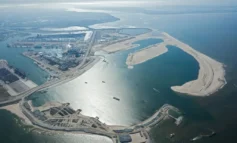
The Analyst: Sustainable port-industrial ‘islands’?
Leave a reply cancel reply.
You must be logged in to post a comment.


Cruise Ship Stabilizers: How Do They Work!
Many new cruises ask about cruise ship stabilizers, what are stabilizers, and how they work.
Well, cruise stabilizers minimize rolling and keep the cruise upright. While sailing, you won’t feel synchronous rolling even in bad weather conditions, and this is because the stabilizers are balancing the center of gravity.
If there is no stabilizer, the bottle of champagne and glasses start spilling drink everywhere, making your cruise voyage worse.
In this article, I will share what cruise ship stabilizers are, how they work and their types. So let’s get started.
Table of Contents
What Are Cruise Ship Stabilizers?
Everyone knows of airplane wings, and cruise ship stabilizers are like them. Two stabilizers are on both sides of the ship, below the waterline.
Both stabilizers of the cruise ship extend outward and downward from the hall. The main purpose of these stabilizers is to keep the cruise upright during extreme weather conditions, minimize rolling, and prevent them from sinking .
The cars have shocks to absorb jerks and make the journey comfortable, and the ships have stabilizers to avoid rolling and make the voyage comfortable.
As compared to old-age ocean liners like the Titanic , stabilizers are a big upgrade in the modern cruise industry.
How Does Cruise Ship Stabilizer Work?

This section is going to be a bit technical. Before understanding how cruise stabilizers work, you must understand what happens if no stabilizers exist.
To begin with, if a cruise ship doesn’t have stabilizers, it will remain upright in the sea, and short waves don’t impact the stability of a cruise.
The center of gravity and buoyancy determines the stability of the cruise. If both these forces align, the ship becomes stable and floats on the sea without rolling .
For your understanding, the center of gravity applies force in a downward direction, whereas the buoyancy opposes the weight of the cruise.
But the wavelength increases under extreme conditions or Swells, disturbing the alignment of the center of gravity and buoyancy. This will increase the chances of cruise ships tipping over.
You can see in the image below that when buoyancy increases on one side, the cruise will lean to the other.
For handling such extreme conditions, the cruises use stabilizers to counter the tipping force and minimize rolling.
Ship stabilizers are like airplane wings that extend outwards and in downward directions. And several kinds of stabilizers curse ship uses.
Types Of Cruise Ship Stabilizer
Mainly cruise stabilizers have two types;
Active Stabilizers
Passive stabilizers.
First, let’s talk about passive stabilizers. Usually, Passive stabilizers are fixed; the most common include Bilge keels. The bilge keels are like fish wings, and they might be one of two on one side of a ship hull.
The passive stabilizers increase the hydrodynamic resistance while rolling dampens rolls and keeps the ship upright.
Most small cruise ships use passive stabilizers to balance the cruise and minimize rolling; they are cheap but less effective.
Most of the famous cruise ships use active stabilizers to counter the force. This type of stabilizer uses advanced technology like gyroscopes, sensors or water tanks to detect the right angle and counter the force by adjusting the wings.
Active stabilizers include fins that change the angle to produce buoyancy force to stabilize the cruise.
Active stabilizers are more effusive than passive stabilizers; that’s why most luxurious cruises use Active stabilizers to ensure smooth voyages.
Does Cruise Use Gyroscopic Stabilizers
The Gyroscopic stabilizers are the type of active cruise ship stabilizer. Mostly, such stabilizers use big wheels or discs to balance the ship’s movement.
When the ship rolls to one side, the gyroscope spins in the opposite direction, generating a torque that helps stabilize the vessel.
But most large cruise ships don’t use gyroscopic stabilizers because cruises are heavier. That’s why a gyroscope for such ships must be large enough to control the rolling. The large gyroscopes are more expensive than active fins.
Also, the gyroscopes don’t efficiently work for large cruise ships, whereas the active fins effectively balance the rolling and provide a smooth voyage.
How Many Stabilizers Do Cruise Ships Have?
The number of stabilizers varies from cruise to cruise. The larger cruise needs stabilizers on each side to maintain the center of gravity and avoid rolling.
Most modern cruise lines, like Royal Caribbean, Carnival, Celebrity, and Disney, use two stabilizers on each side of the cruise ship. But few big ships like Cunard Line’s Queen, Royal Caribbean Freedom and Oasis use four stabilizers, two on each side.
As larger ships are heavier, the two stabilizers are not enough to counter the forces and reduce the ship’s rolling motion.
What Will Happen If Stabilizer Fails?
Most of the cruisers ask what will happen if cruise ship stabilizers fail. This is a very exceptional case; the stabilizers won’t fail during voyages.
If stabilization fails, the passengers will experience a lot of rolling and pitching motion, making them uncomfortable. Enjoying champagne onboard will become tough, and the onboard activities will become more challenging.
With the increase in rolling motion, seasickness also becomes more prevalent, ruining all your entertainment and making your journey worse.
However, large and heavy cruise ships have a huge center of gravity and buoyancy force that requires more force to roll. That’s why, in most cases, large cruise ships don’t roll even if their stabilizers fail.
Secondly, modern cruise ships are designed to remain upright without stabilizers, so you don’t need to worry about rolling on a cruise ship.
Impact Of Stabilizers On Speed & Fuel Efficiency?
Undoubtedly, the stabilizers affect the speed of cruise ships . The old traditional stabilizers like gyroscopes add tons of weight that reduce the speed.
But the modern stabilization system, like active fins stabilization, uses sensors to detect waves so they don’t weigh too much. Also, these are retractable stabilizers that only come out when a surge or swell occurs.
The flat stabilizer fin creates more resistance against water that can reduce the speed up to 10 per cent, whereas fuel consumption also increases due to greater force.
Conversely, if a cruise ship uses curved fins, they don’t impact the speed and fuel consumption. These fins create more lift and easily counter the forces. That’s why curved active fins are even more effective during high speed.
Quantum Anti-Rolling Stabilization Technology
Most luxury cruises, yachts and vessels use Quantum anti-rolling stabilization. According to a report by quantum stabilizers,
Around 85% of the super yachts use quantum stabilizers
In 2000, Quantum invented the first zero-speed stabilization technology. This technology generates more lift force to minimize the rolling effect.
Later, the Quantum Maglift Rotor Stabilizer revolutionized the cruise industry. These stabilizers work on the “Magnum Effect” principle, where the rotating cylinder generates lift from its expected trajectory. In this way, these stabilizers provided more comfort at low speeds.
The successor of Maglift Rotor was Dana-Foil, which offers retractable fins. These stabilizers use less power and drag but produce more lift. And till now, Dyna-foil stabilizers are a more efficient Quantum Stabilization system.
Final Words
Cruise ships stay upright and provide maximum comfort, all possible due to stabilizers. On either side of the ship, fin stabilizers minimize the rolling motion and provide a comfortable voyage.
Most modern cruises use active curved fins that reduce the ship’s roll without impacting the speed and fuel consumption.
FAQs About Cruise Ship Stabilizers
How much does it cost to install stabilizers on a cruise ship .
The cost of installing a stabilizer on a cruise ship varies and depends on the type of stabilization system, cruise weight, design and other requirements. According to reports, the stabilizer system costs $65,000 for 50 to 60-foot vessels and $130,000 for 120 to 130-foot vessels.
Do cruise ships turn off stabilizers?
Cruise ships often turn off stabilizers when the sea waves are normal. Most stabilization systems produce more drag against water, impacting fuel consumption and speed.
Which type of stabilizer is the most popular and fitted to most ships?
Most of the modern cruise lines use active fin stabilizers. They are retractable, and the cruise captain turns them off when the sea is calm. This stabilizer saves fuel and is more efficient than gyroscopes or passive stabilizers.
Can the ship safely sail without stabilizers?
Yes, cruise ships can sail safely without stabilizers, but when it comes to comfort level, you won’t experience it as there is so much rolling motion without stabilizers.
I am Zoe Grace, a passionate enthusiast of cruise ships. With a decade of firsthand experience in the cruising industry, I have developed a deep understanding of the intricacies and wonders that these majestic vessels hold.
Now, I am excited to embark on a new journey as an author, sharing my knowledge and insights with readers who share my fascination for the world of cruising.
Join me as we explore the captivating world of cruise ships together.
Similar Posts
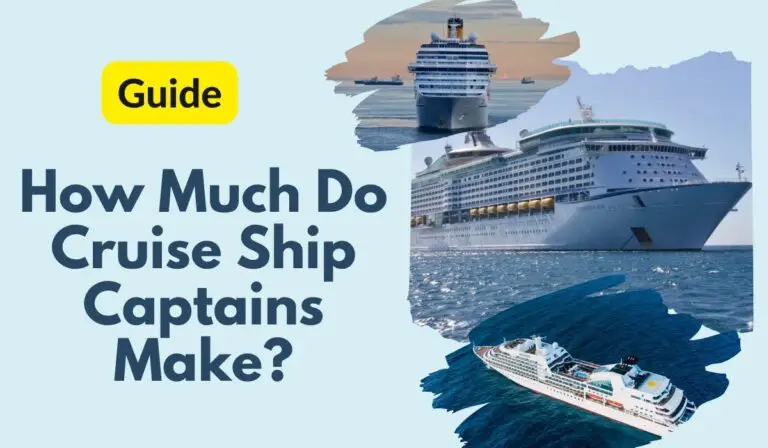
How Much Does a Cruise Ship Captains Make In 2024?

Cruise Packing List: 24 Must Have Items To Pack For Cruise
![cruise ship vertical How Long Is A Cruise To The Bahamas? [Expected Time]](https://cruiseshipmania.com/wp-content/uploads/2023/09/Carnival-Cruise-Menu-6-768x448.jpg)
How Long Is A Cruise To The Bahamas? [Expected Time]
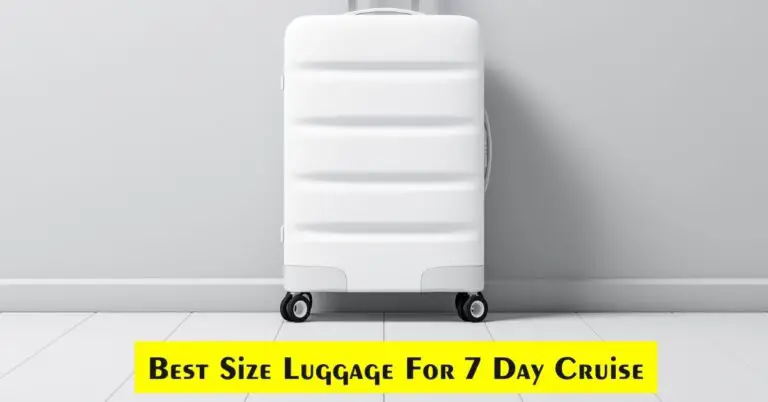
Best Size Luggage For 7 Day Cruise in 2024
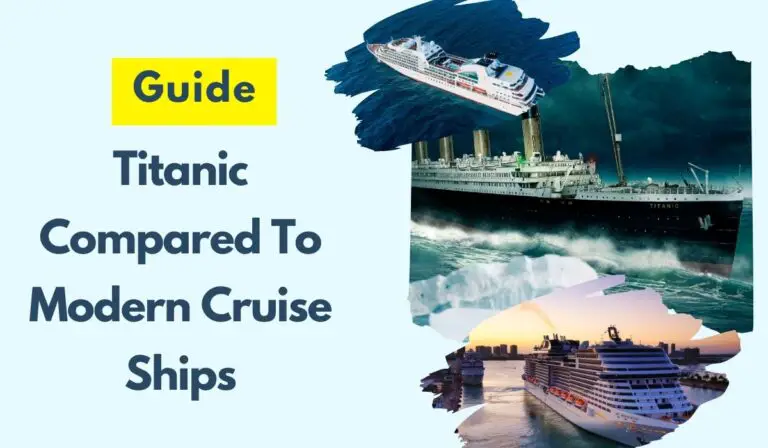
Titanic Compared To Modern Cruise Ships

17 ESSENTIAL THINGS TO PACK IN YOUR CRUISE CARRY-ON BAG

Port Economics, Management and Policy
A comprehensive analysis of the port industry
Chapter 3.6 – Cruise Terminal Design and Equipment
Author: dr. athanasios pallis.
Cruise terminals have a unique set of characteristics and operational considerations since they need to handle a large number of passengers and cruise ship supplies.
1. Cruise Terminals
Cruise terminals are designed to serve the requirements of cruise vessels and their passengers . At the same time, they have to be integrated with transport, tourism, and the urban planning strategies of the port city and nearby destinations. From a maritime viewpoint, cruise terminals need to fulfill minimum requirements for draft, berthing lines, and navigation channels for cruise ships. Inside the cruise terminal, there are provisions for various spaces, including the apron area, terminal building, and ground transportation. Due to the nature of their customers and the nature of cruise operations, connectivity to the city, car parking, and public transport facilities are particularly important.
Operational considerations are a critical factor in implementing the design of a cruise terminal is carried out at a specific port. The cruise port’s function as a home port, a transit port, or a hybrid port, implies different needs and design considerations:
- In a home-port , the cruise vessel that begins or concludes its itinerary commonly arrives early in the day so that passengers proceed to customs and immigration, have their luggage (un)loaded, and make their flight connections (more an issue for arriving passengers). Provisions for the next cruise need to be loaded, baggage from arriving passengers scanned and loaded, passengers processed through ticketing, spare parts, deck supplies, and bunkers (potable water and fuel oil) taken aboard. Minor repairs may also be undertaken. A portion of the crew visits the port city and returns before the ship departs. All these activities need to take place within up to 24 hours and preferably within 12 hours. Handling a large number of passengers in a short amount of time requires a terminal building, parking areas, and good access to the local transport system, particularly airports. The conditions and performance of the cruise port terminal are strongly linked with homeports selection by cruise lines.
- A port of call (transit) is visited for only a few hours within a day, or overnight, and requires a fast and efficient system for transporting passengers to points of interest or recreational spots.
- Hybrid cruise ports are used for both home-porting and transit activities. The terminal is designed to handle home-port and visitor flows at the same time.
Once designed and constructed, the operating costs of cruise terminals are generally smaller than in other port terminals , as cruise terminals do not require heavy equipment and do not consume much energy. The main operating cost items are the staff for managing the terminal, security, and luggage handling. These are frequently outsourced owing to the seasonal nature of the industry. On the other hand, security is a fundamental issue as cruise ships and passengers at ports might be vulnerable. A large number of passengers concentrated in a small restricted area might be considered a potential risk. Cruise ships also have high symbolic and economic value. Consequently, cruise port design and operations must comply with several security regulations, while cruise lines and regulatory agencies constantly audit port security.

2. Maritime Infrastructure
The core consideration for cruise terminal design is related to the expected technical characteristics of the cruise ships . Indicators, such as the tonnage, overall length (LOA), beam, and draft of modern cruise ships, along with the passenger capacity, and the number of crew on board, are the most considered. Due to the range of cruise vessel types, sizes related to cruise ships scale of dimensions and capacities , the maritime infrastructure of a cruise terminal depends on several factors:
- The number, size, and class of the cruise vessels that could utilize the terminal. Since the 2000s, the average size of cruise ships has increased in all dimensions (i.e. larger, wider, and higher passenger capacity). The average cruise ship capacity has increased from 1,300 to 3,100 passengers, and the average length from 200 to over 300 meters.
- The characteristics of the vessel types that could call at the port are key aspects. Due to design changes and technology, the mass and dimensions of cruise vessels include a variety of deck designs. These features contribute to the design of shoreside infrastructures like shore-power location, gangway placement, and cruise terminal building dimensions and facilities.
- Operational conditions imposed by weather. Some cruise ports may be exposed to the seasonality of weather risks, such as hurricanes in the Caribbean.
- The operational needs of stevedoring for activities such as mooring, bunkering, and stores.
- The desired potential berthing patterns and the average number of cruise ships expected to be docked.
- For home-ports, the number of crew members is also significant. Depending on the size and market segment of the cruise, the ratio varies from one crew member per passenger in a luxury cruise ship to one crew member per three passengers in a standard ship.
Entrance channels to berths and maneuvering areas provide safe clearance during vessel movements and operational loading conditions. Their minimum depth incorporates the maximum draft and allowances for technical and wave conditions anticipated during vessel approaches. Modern cruise vessels are very maneuverable in most sea conditions. The berth area length required for safe mooring and securing the vessel allows for a minimum clearance of 10% of the vessel’s overall length (LOA). Where turning basins are required, a diameter of two times the LOA plus an allowance for adverse weather conditions is necessary. In home port operations, the port maintains contingency plans in case of extreme weather due to the need for passengers to connect to the various modes of transportation from the terminal. Ports of call do not need such plans, as ships have the option of skipping a port of call in the case of inclement weather.
Mooring of cruise vessels generally uses arrangements where the maximum pier frontage adjacent to the vessel offers loading/unloading efficiencies. In some transit ports, vessels are moored to piers shorter than the vessel, using dolphins to secure the offshore end of the vessel. Cruise vessel facilities are typically provided with fender systems along the full frontage of the berth area to absorb the energy of an impact during vessel berthing and provide a soft buffer between the pier and vessel while moored.

3. Apron Area of the Cruise Terminal
Aprons are fenced secured areas immediately adjacent to the cruise building and vessel service doors. While cruise vessel loading can occur with small widths of apron surface, the wider and less obstructed the surface in the area is, the better. The apron area provides space for any of the following operations:
- Stevedoring services including line-handling, baggage movement, utility connections, and waste processing from the vessel. Luggage is moved by forklift and baggage handling carriages from/to the ground floor of the cruise building to/from the vessel luggage doors.
- Supplies to the vessels to serve the needs of passengers, crew, systems, and equipment. The provisions arrive on trucks soon after the ship arrives at berth. With larger ships served by a total of between 20 and 40 tractor-trailer size trucks, managing this flow and providing proper maneuvering, unloading, and turn-around space is critical to the success of this process. In addition to space, two other factors are important, connectivity with the ground transportation area, and storage areas where certain perishable provisions can be placed before being loaded onto the ship in order to avoid any damage.
- Access for vehicle circulation, parking, unloading, and access for load/unload equipment.
- Emergency vehicle access .
- Provisions for site-specific needs of terminal operations, such as vehicle controls.
All these operations take place in the apron area via the various service doors of cruise vessels . Within the apron, the operational pier service loading area for vehicles servicing cruise vessels, such as containers and tanker trucks, is separated from the cruise terminal passenger areas. Gangways are the single most important passenger processing element of the entire terminal as they are crucial for turning vessels around quickly and efficiently.
The gangway (also known as seaport passenger boarding bridge) is the means of getting on and off a ship. In general shipping terms, it refers to a walkway or bridge connecting the vessel to land. Because access varies widely from one port to another, a cruise ship gangway refers to the place on the ship where passengers enter and exit.
Gangways transfer passengers from the vessel doors to the terminal building through the boarding corridor (boardwalk). For example, on embarkation and debarkation days, the gangway will often consist of an enclosed raised bridge like a jetway in an airport. For larger vessels, the embarking and disembarking processes entail the need for two fully automated mobile gangways per berth to move in excess of 1,000 passengers per hour. Cruise terminal operators might select one of the various types of cruise gangways available to meet these needs and provide safe boarding in all conditions.

For home-ports, the demand for some or all of the following vessel utilities might require further infrastructure that might even extend beyond the facility property in order to provide sufficient capacities to allow vessels to be serviced during their limited time at berth:
- Bunkering for ship refueling.
- Waste reception facilities such as oily wastes, garbage from ships, and sewage.
- Potable water . A 3,500 passenger vessel can use approximately 1.40 million gallons during a seven-day excursion. Most of this water demand is provided through onboard desalination systems. However, it is not uncommon for cruise vessels to take on water while at the pier.
- Ballast water .
- Energy such as shore power (cold ironing and LNG provisioning).
4. Cruise Terminal Building
The presence of a cruise terminal building is part of the evolution of the cruise business. As the market matures, cruise ports have started developing purpose-built terminal buildings to serve cruise passenger movements. Still, for ports where cruising activities are in their initial phase, the terminal is often a temporary structure, or a building primarily having a non-cruise use and is convertible on the days a ship calls. A range of structures is used:
- Temporary cruise terminal buildings exist in cruise ports with few calls and are managed only when a ship is calling. This includes vessel navigation and berthing, provisioning, passenger debarking, ship hoteling, passenger embarking, and vessel deployment. The methods of handling these needs rely primarily on essential services only, and on occasion, there is no building dedicated as a cruise terminal. In these cases, organizing and segregating functions are handled on-site with temporary event-type facilities with movable barriers, traffic control elements such as bollards and cones, and tape lines.
- Convertible cruise terminal buildings focusing on hospitality, civic, commercial, retail, or warehousing as the primary function. As these facilities are not specialized cruise terminals, passengers, baggage, and supplies are managed on a day-of-cruise basis. Before a ship berths, specific cruise use elements such as signage, furniture, equipment, and space-dividing material will be set up for a cruise and then removed after the ship departs. Several processes (including immigration) may be handled on the vessel rather than in the terminal.
- Purpose-built cruise terminal buildings address the entire needs and functionality of cruises on both disembarkation and embarkation. On occasion, some of the building spaces may be designed for dual-use (embarking and debarking). Most often, each space is designed and built for specific functionality. These buildings can also have secondary uses such as event space for shopping areas, cafeterias, and restaurants. Sill, cruising remains the primary design and operational driver. Embarkation and disembarkation spaces, equipment, furniture, signage, and agency requirements are all designed to optimize flow, heighten passenger satisfaction, minimize staffing levels, and maintain security. Often these buildings are part of a larger port community, or combined waterfront context, but they stand alone, not usually offering other uses when no ship is at berth.
- Mixed-use cruise terminal buildings are the most developed response to cruise tourism, along with the need to serve a waterfront community. Recognizing the multi-functionality that a single building can provide, such mixed-use buildings include all the necessary elements of a purpose-built terminal. They also add other uses to their plan and volume, such as shopping areas, commercial areas, theatres, and conventions. As with other mixed-use buildings, the economics of capital investment, operating cost, and revenue stream are combined in order to benefit from multiple uses. This creates a beneficial cycle of increased use, greater revenue, heightened visibility, and a stronger tourism market. Simultaneously, regardless of whether or not cruising is the dominant purpose of the mixed-use building, the cruise market must perceive that the building is successfully serving the core cruise terminal mission.
Cruise terminal buildings are either single-story or multi-story . A single-story terminal has the advantage of fitting on an open site, especially in relation to the length of a cruise vessel and the need for ground transportation, and the absence of vertical core elements such as stairs, escalators, and elevators. On the negative side, the operational distances are longer on one level than in multi-story terminals. Multi-story terminals are becoming the more common form of cruise terminal buildings, especially in the bigger home-porting cruise ports. This format takes advantage of the inherent differences between embarkation and disembarkation processes to segregate them by floor level, a design common in airport facilities. The stacking of spaces on different levels has greater advantages when co-locating other activities, such as parking. Most often, a multi-story terminal will have the majority of disembarkation spaces on the ground floor and most of the embarkation space on the upper level. This has the operational advantage that embarking passengers are brought upstairs to check-in and wait to board while disembarking passengers flow through immigration check, baggage pickup, customs, and ground transportation pickup.
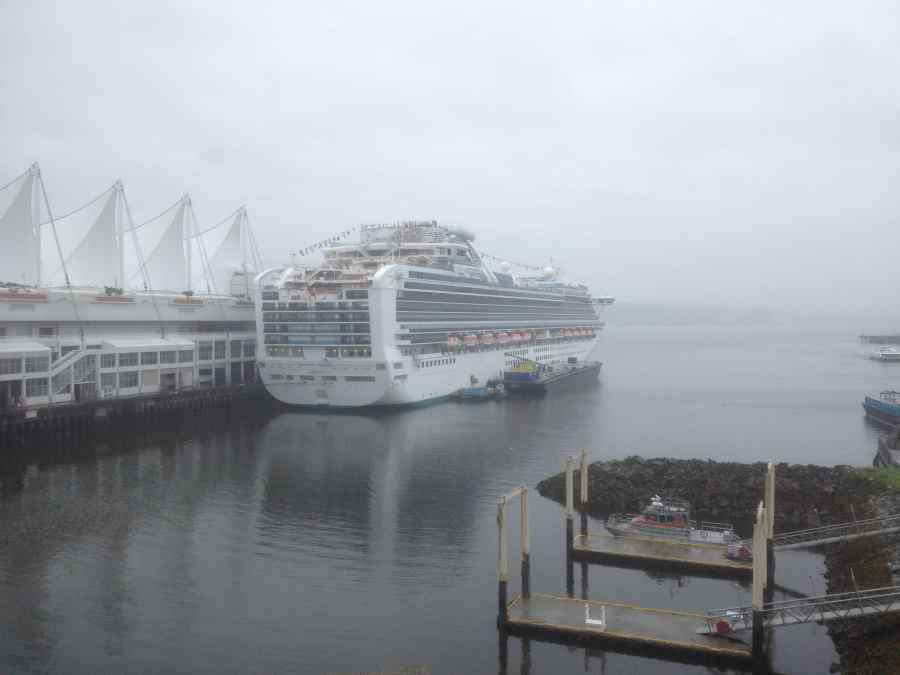
5. Embarkation and Disembarkation Processes
The embarkation process of cruise passengers begins upon arrival at the cruise terminal. In home-ports, a number of different spaces and services are provided to facilitate the process:
- Entrance space is a gathering space for passengers arriving at the terminal, a shelter from the weather, a place to seek information, and a place to queue for the next step in the process.
- Bag drop space where bags are brought for the security check and organizing prior to loading onto the ship.
- Luggage security controls (X-ray scanners ) that allow thorough luggage monitoring, and detecting objects that are not allowed to be taken on board.
- Queuing space that includes multiple lanes for passengers to process through security controls boarding the vessel.
- Passenger security controls (passenger X-ray lanes), with operating schedules adapted to the size of traffic, peak hours, and other local and cruise-ship requirements.
- Ticketing where passengers pick up their tickets before check-in if not available through prior arrangements.
- Ticket area queue where passengers queue before checking in so that people can move quickly from ticketing to boarding.
- Check-in area with counters where cruise-line staff process passengers for the designated cruise trip. The use of new technologies like mobile applications or bar-coded wristbands in the check-in process is already bringing changes in the layout of this area.
- Waiting areas for checked-in ticketed passengers to wait until boarding can begin. This space is large enough to allow for ample seating and circulation area, as well as space for cruise information and other pre-travel material the cruise lines have.
- Boarding corridors where passengers move toward the vessel.
- Staff offices for cruise operator staff, cruise line staff, and port security.
- Other spaces, such as spaces where passengers can have their pictures taken, VIP lounges separated from the general embarkation experience, and even wedding and other special group spaces.
The size and location orientation of each of the above spaces and respective services varies from one cruise terminal to the other. Not all of the spaces listed will be found in every terminal or found in similar arrangements. Security might take place at the entrance of the terminal building or after check-in. Well-developed VIP spaces do not exist in all terminals, as the configuration is determined to meet the needs of all stakeholders (port, cruise lines, operator, customs, and port security). In any case, the terminal needs to offer a positive experience to passengers , as it might provide the first impression to the embarking passengers and it is thus valued significantly by cruise lines. Further, if the terminal is too small for the capacity of the cruise ship, discomfort can result from passengers being forced to stand up in crowded spaces over periods of time.
The disembarkation process in the home port begins before a passenger leaves the vessel to enter the terminal, aiming at reducing the processing time to a minimum and maximizing this final experience for the passenger. The different spaces and services that are provided in home-port terminals include:
- Boarding corridors for disembarking passengers.
- Customs, immigration, quarantine, and police spaces and processes.
- Baggage lay down , which is often the single largest space in the building. Luggage is brought directly from the ship according to deck level and grouped via a “lay-down” process that takes place before passengers enter the space. While in most cases separation refers to baggage waiting in different spaces per group of passengers, more sophisticated processes of managing bags also exist, the most obvious being carousels such as those used in airports.
- Customs areas for passengers to proceed after luggage collections to processing counters, and to conclude applicable procedures.
- Meeting spaces where passengers gather and meet with others and move to ground transportation.
In ports of call, the disembarkation/embarkation processes are less complex, particularly since passengers do not carry luggage. The terminals do not usually have or need a building to host passengers since the (dis)embarkation time is normally short, lasting less than an hour, with access to the local means of transportation or to the walkways and back to the ship having to be as fast and simple as possible. In the absence of a terminal building, the port provides an open space along the quay to enable passengers to gather comfortably. If a terminal building exists, transit terminals do not require spaces for the check-in process or luggage operations.
6. Ground Transportation
The ground transportation area of a cruise terminal is where passengers arrive from all transport modes to embark on the cruise. It is also where they disembark to take any transportation mode to travel inland, usually through public roads and transit systems. Since the passengers of a single cruise generate large numbers of inland trips , ground transportation is an important function of the cruise terminal. As traffic needs to move quickly, safely, and efficiently from and to the terminal and from and to the city, this area must be located close to the terminal building. The ground transportation area includes spaces for:
- Coach parking , such as shuttle buses provided by the port or the cruise lines and tour buses provided by the ship and independent excursion buses.
- Taxi lines with comfortable space around the cars to facilitate loading and unloading.
- Drop-off spaces such as a short-stay car park earmarked for people dropping off or picking up passengers.
- Parking spaces for passengers who drove to the terminal to take a cruise.
- Regional and local connectivity to both the local and regional intermodal system, such as the airport, needs to be connected to the home port by rail or road.
The modal distribution of cruise passenger mobility differs by port. Passengers can decide to take a coach, a taxi, a private car, or go on foot depending on factors such as proximity to major hotels and connectivity to the regional transport system. Space assigned to ground transportation services at a cruise terminal depends on:
- Type of cruise vessel operations at the port of call, with buses and shuttles being the main transport mode. In a home-port taxis and private transport are the most used transport mode, together with transfers and connections with the airport.
- Port-city distance where the cruise terminal is within a metropolitan district, most of the passengers might go into the city by foot, depending on the presence of pedestrian corridors. However, if the city is far off a shuttle system transport is provided.
- Transport systems available as several transport modes and services near the terminal area, such as car parks, train connections, and airport connectivity, are considered.
- Other factors such as local, regional, and environmental considerations may affect the design criteria. A terminal in an area of recurrent high temperatures may need to provide air conditioning in most ground transportation areas. In contrast, a terminal in an area prone to security risks will need to ensure that these areas are secured.

In addition to infrastructures such as quays construction, dock expansion, dredging of channels and basins, waiting areas, and gangways that improve traffic flows and accessibility, modern cruise terminals also involve shoreside projects . In many cases, land reclamation, retail, restaurants, and hotels are of equal importance. The multi-purpose use of cruise terminals is of a different type. Due to their service and touristic orientation, the terminals are ‘people-friendly’, rather than ‘cargo friendly’. Thus, they might be used with open access to the public for events or other usages. This is especially the case as the seasonality of cruise activities implies that several terminals host cruise ship calls for only a few months each year.
Beyond the change in the usage of existing infrastructure or the development of greenfield projects, recent developments have also revolved around the adaptive reuse of brownfield assets . Such cases can be found in the United States, both at the East (Brooklyn and Galveston) and the West (San Francisco and San Diego) coasts. In all cases, cruise port infrastructure development takes far longer than building new cruise ships, meaning that ports may lag behind in trying to meet vessel capacity developments in the market.
Related Topics
- Chapter 3.1 Terminals and Terminal Operators
- Chapter 3.2 Terminal Concessions and Land Leases
- Chapter 5.4 Port Pricing
- Chapter 8.1 Cruise Ports
- Cheng, Z. Gong L. and Li C. (2020). Design and Practice of Cruise Ports. Singapore: Springer .
- Pallis, A. A. 2015. “Cruise shipping and urban development state of the art of the industry and cruise ports”. OECD-ITF Discussion Paper 2015-14 , OECD: Paris.
- PIANC Working Group 152 (2016). Guidelines for Cruise Terminals. Brussels: PIANC.
Share this:
- First Time Cruisers
Best way to carry ship card

By KaDarr , March 10, 2015 in First Time Cruisers
Recommended Posts

How big is the ship card? Is it vertical or horizontal? What is the best way to carry it around? We got the beverage package on an Alaskan NCL ship so I know we have to have our cards with us just about all the time. A badge holder? Any thoughts greatly appreciated.
Link to comment
Share on other sites.
Yes, I think a lanyard with a badge holder works great. Some folks have a hole punched in the card for greater safety.

It's the size of a credit card, or driver's lic....hubby puts his in his pocket, I carry a small purse, with my lipstick, comb, etc.....
How do you carry your room key at a hotel? Do the same! It's your cabin key....
Well, when we're in a hotel, I usually put it in my back pocket if I leave the room. I think I'm going to get these for my hubby and I. http://www.amazon.com/dp/B0098XJUO2/ref=wl_it_dp_o_pC_S_ttl?_encoding=UTF8&colid=1XFYGAMJI0MPP&coliid=IXLZUW7GJTHZZ&psc=1
sg1phileshipper
Another vote for a lanyard. And if you take one that holds two, you can put your drivers licence in there when going ashore. Enjoy your cruise
Verzonden vanaf mijn iPad met Tapatalk
We also use lanyards. We go to the front desk and they will punch a hole in the card. (at least on Princess)
However, we do NOT use the lanyard ashore. There we put the card in our pockets. We do not want someone mistaking the lanyard for something of value and trying to grab it.
On Carnival Ships they will punch a hole and put it on a string for you in the casino... ;)
crystalspin
I got these:
http://www.ebay.com/itm/New-Rhinestone-Bling-Crystal-Cell-Phone-ID-Badge-Holder-Lanyard-Necklace-NWT-/221440684372?pt=LH_DefaultDomain_0&var=&hash=item338ee4b154
For my mom and I on last cruise, and it was WAY too much trouble to take the cards out, we quickly ditched the "frame" thingee and had them punch holes in the cards at the main desk. However the price on Amazon is as good as any for just the string anyway. (You do know you linked to a package of FIVE lanyards, right?)
What I also discovered was that wearing it around my neck whilst also wearing my phone/phablet (as it is my camera as well) repeatedly de-magnetized the card. I didn't think it was so, as I carry a credit card in the same (non-neck) wallet as the phone at home, but I later read on these forums that it is true! So up-coming cruise, will carry my S&S card key on a keyring with mini-carabiner NOT on my neck.
I had an issue with my card "de-magnetizing" but it turned out it was due to the magnetic cover on my iPad.
Keeping the cruise card next to a camera or other device will de-magnetise it
Very good information, Thank you! I will do the same!

I use a dog show clip (if you google European dog show clip it will make sense) they come in all sorts of designs and pin onto clothing.

harleysmama
I have to wear a lanyard at work and don't want to wear one on vacation. So I just use my pockets or a very small purse.

Cru1s1ng2009
glad someone feels the same! It feels like work if I have a lanyard or a clip with a retractable cord. I would rather lose 5 cards and get new ones than use a lanyard on a cruise. I don't want anything to remind me of work.

Cruisin' Chick
I have a lanyard with a sleeve attached. It's easier for me to automatically put it on my neck, rather than worrying if I've stuck it in my purse (I might not always have a pocket to use). For going off the ship, I do put it in my purse once I've had it scanned on the gangway.

Steviewonder1
Never outside but when ashore drop it inside the shirt/t-shirt and re-check the collar to insure it is not visible. These are a most wanted item when off the ship in any foreign land, island, nation. Also wear "Grey Person" attire when off the ship so you do not get marked as a Tourist! That means nothing nothing fancy when you get off the ship. If you do you will get hits from all the local "You need this Salesfolks"

If you have ever been locked out of your room at midnight because you left your room key in your other pants pocket, as I have done, you will learn to appreciate a lanyard. It was a long walk to the Front Desk in my bare feet in Alaska to get a new card.
My lanyard now is around my neck from the time my feet hit the floor (with the exception of shower/shaving) until my feet go under the sheets at bedtime while aboard ship.
After being scanned off of the ship, the room-key lanyard goes into a pocket.
FWIW you can grey-out but your backpack, camera, ship's shopping bag, hairstyle, manner of walking, etc. are a dead giveaway that you are a tourist. If you go completely incognito with none of the above, your shoe style will shout "not local". You cannot fool the locals so just go "comfortable tourist" and when being confronted by an aggressive salesperson, let them know that your spouse has all of the money and you don't know where they might be.

I too wear a lanyard at work and it must have a breakaway as I work with power equipment. OHS requirement. I will wear the lanyard on the ship as sometimes I have no pockets. Swimsuit.
However, the lanyard from Princess does not have a breakaway and for the ship this is fine. Yet, on shore excursions having a solid lanyard is a liability from a personal safety point of view in public places. You are passing thru public streets with a solid rope about your neck. What could go wrong?
Move your card to wallet or pocket to get this small level of personal safety. My 3 cents.

Lulubelle45
Just a heads up on the lanyard. On Celebrity last year, a fellow passenger bought the lanyard with plastic case on the ship. While she was in port she lost her card, the plastic hole broke and she had no idea where it went. I also had the same lanyard and mine broke too before the cruise was over. I think k a hole punched in the card is far more secure.
If you have ever been locked out of your room at midnight because you left your room key in your other pants pocket, as I have done, you will learn to appreciate a lanyard. It was a long walk to the Front Desk in my bare feet in Alaska to get a new card. My lanyard now is around my neck from the time my feet hit the floor (with the exception of shower/shaving) until my feet go under the sheets at bedtime while aboard ship. After being scanned off of the ship, the room-key lanyard goes into a pocket. FWIW you can grey-out but your backpack, camera, ship's shopping bag, hairstyle, manner of walking, etc. are a dead giveaway that you are a tourist. If you go completely incognito with none of the above, your shoe style will shout "not local". You cannot fool the locals so just go "comfortable tourist" and when being confronted by an aggressive salesperson, let them know that your spouse has all of the money and you don't know where they might be.
lol..exactly and 100% correct. I love the advice about blending in. They can spot a tourist, especially if it's a pick-pocket in Europe or someone that has bad intentions. Just be cautious, same as if you were a tourist in a city in the U.S. Be aware of your surroundings and enjoy getting to be a tourist in a wonderful place...and use a lanyard. I had to wear one when I was working to, but I was never able to use it to get a margarita or a frozen drink with an umbrella ;).
FIDDLE2FADDLE
I just place my card in the top part of my bra - easy to find and easy to put away and I always know where to find it!

What a novel idea. Now I can leave my bow tie at home to save luggage space and just wear my lanyard and room card with my tuxedo :D
It is the same size as a credit card. It is printed in portrait, but it depends on how you hold it as to whether is is vertical or horizontal. Personally I carry it in my pocket. However, if you are comfortable with it in a card older and allowing everyone to see it, then a card holder will work.

Honestly, I wear a lanyard as well. I think it's just the easiest thing I have found. Especially ladies, you know how sometimes you may have a sundress on or some type of slacks without pockets etc. I just like having somewhere to always have it. On our first cruise the first few days my husband offered to put it in his pocket for me, but if we would separate, sometimes he would forget and I would be without my card.
I obviously don't carry a purse anywhere on the ship, so yeah a lanyard just works so well.

Only trouble with a lanyard is my card demagnetized every time I used my ipad. Had to have my card replaced 5 times on my last cruise.
Please sign in to comment
You will be able to leave a comment after signing in
- Welcome to Cruise Critic
- New Cruisers
- Cruise Lines “A – O”
- Cruise Lines “P – Z”
- River Cruising
- Cruise Critic News & Features
- Digital Photography & Cruise Technology
- Special Interest Cruising
- Cruise Discussion Topics
- UK Cruising
- Australia & New Zealand Cruisers
- Canadian Cruisers
- North American Homeports
- Ports of Call
- Cruise Conversations
Announcements
- New to Cruise Critic? Join our Community!
Write Your Own Amazing Review !

Click this gorgeous photo by member SUPERstar777 to share your review!
Features & News

LauraS · Started Friday at 03:25 PM
LauraS · Started Thursday at 04:36 PM
LauraS · Started Thursday at 03:57 PM
LauraS · Started Thursday at 01:42 PM
LauraS · Started Thursday at 10:13 AM

- Existing user? Sign in OR Create an Account
- Find Your Roll Call
- Meet & Mingle
- Community Help Center
- All Activity
- Member Photo Albums
- Meet & Mingle Photos
- Favorite Cruise Memories
- Cruise Food Photos
- Cruise Ship Photos
- Ports of Call Photos
- Towel Animal Photos
- Amazing, Funny & Totally Awesome Cruise Photos
- Write a Review
- Live Cruise Reports
- Member Cruise Reviews
- Create New...

The 6 best cruise ship waterslides and watery fun zones
MSN has partnered with The Points Guy for our coverage of credit card products. MSN and The Points Guy may receive a commission from card issuers.
Call it the Battle of the Waterslides.
In the last few years, the big boys of the cruise industry — Royal Caribbean , MSC Cruises , Norwegian Cruise Line and Carnival Cruise Line — have been locked in a game of one-upmanship when it comes to waterslides and watery fun zones on vessels.
In addition to such over-the-top, new attractions as go-kart tracks and roller coasters , the brands behind the biggest megaresorts at sea have been packing the top decks of their vessels with even more over-the-top watery allures.
For more cruise guides, news and reviews, sign up for TPG’s cruise newsletter .
Royal Caribbean, for instance, added an 800-foot-long “water coaster” to the back of its 3,386-passenger Navigator of the Seas just a few years ago. It’s one of more than two dozen giant waterslides the line has added to more than half a dozen ships in the last seven years.
Royal Caribbean also plans a record six waterslides on its next new ship, Icon of the Seas, which is scheduled to debut in January 2024.
But as recently as early 2016, Royal Caribbean didn’t have a single waterslide on any of its vessels.
MSC Cruises also has gone big with giant water parks in the past seven years, with as many as four waterslides on more than half a dozen of its newest vessels. Norwegian has loaded up its most recent ships with giant water parks, too — some have as many as five waterslides!
Not to be outdone, Carnival, an early adopter of waterslides on ships, has added sprawling water park areas with multiple waterslides to almost every vessel in its fleet.
A brief history of water attractions at sea
In the beginning, there was the pool. As watery cruise ship attractions go, it has long been the staple — something found on nearly every cruise vessel going back to the 1970s.
But as early as 1978, at least one line was spicing up its Lido decks with a little waterslide fun — little being the operative word. That’s the year Carnival added a single slide into the pool on its 728-passenger Festivale — a slide so small it’s now hilarious to think it was touted as an attraction.
Often cited as the first waterslide ever on a cruise vessel, the Festivale slide was of a sort that was found at backyard pools at the time. The cruise industry was still in its infancy, of course, and ships were orders of magnitude smaller than they are today. Festivale measured just 32,697 tons, about one-seventh the size of today’s biggest cruise vessels.
Carnival, the so-called Fun Ship line, would go on to become the early leader in waterslides at sea. The 2,056-passenger Carnival Fantasy, which debuted in 1990, was the first cruise ship with a significant waterslide. It measured 115 feet in length.
Related: A beginner’s guide to picking a cruise line
Just six years later, in 1996, Carnival would make news with the unveiling of a 214-foot-long corkscrew waterslide on what then was called Destiny. (The ship currently sails as the Carnival Sunshine after being rebuilt in 2013.) At the time, Destiny was the biggest cruise ship in the world.
In more recent years, Carnival has gone into waterslide-building overdrive. The line has added full-blown water park areas with waterslides, watery play zones and other features to all but four of its 25 ships. All but one of Carnival’s ships (Carnival Luminosa) now have at least one waterslide.
One of the Carnival water parks, on the line’s 5-year-old Carnival Horizon, even has Disney-style theming revolving around Dr. Seuss characters.
Norwegian, MSC Cruises and Royal Caribbean only began going big with waterslides on ships in the past decade or so. Many of the newest vessels from the brands have massive water park areas. Some of the brands are retrofitting big waterslides onto older ships, too.
Additionally, family-focused Disney Cruise Line now has major water attractions on all its vessels.
Where you’ll find the biggest waterslides at sea
If your idea of the perfect cruise ship is one loaded to the gills with waterslides and watery fun zones (plus all sorts of other over-the-top attractions), you’ll want to stick to the biggest floating megaresorts operated by Royal Caribbean, Norwegian, MSC Cruises and Carnival.
At Royal Caribbean, that means the giant Oasis-class vessels , which include Wonder of the Seas — the world’s largest cruise ship. At Norwegian, you’ll find the biggest waterslides and water parks on the line’s relatively recently built Breakaway Plus-, Breakaway- and Epic-class ships. At MSC Cruises, the new Seaside-, Meraviglia-, Meraviglia Plus- and World-class vessels have the line’s big water parks.
Big lines that have steered clear of the water-park-at-sea trend include Princess Cruises, Holland America and Celebrity Cruises. Geared more toward couples than families and typically drawing an older demographic, all three of these lines have stuck to a more subdued feel for the outdoor areas of their ships. The top decks of vessels operated by Princess, Holland America and Celebrity still mostly revolve around traditional swimming areas with pools, hot tubs and lounge chairs.
Ready for a splashy, top-deck thrill? These are the most spectacular watery attractions at sea.
The Perfect Storm
Where you’ll find it: Royal Caribbean’s Wonder of the Seas, Symphony of the Seas, Harmony of the Seas, Oasis of the Seas, Liberty of the Seas and Voyager of the Seas.
This isn’t just one giant waterslide; it’s a whole complex of waterslides, each one among the most exciting you’ll find anywhere on the world’s oceans.
The Perfect Storm is found on four of Royal Caribbean’s massive Oasis-class vessels — Wonder of the Seas, Symphony of the Seas, Harmony of the Seas and Oasis of the Seas — as well as the smaller Liberty of the Seas and Voyager of the Seas. The complex includes two four-deck-high racer slides called Cyclone and Typhoon, where you can do side-by-side speed tests with your travel partner.
On the four Oasis-class ships, there’s also a third, Champagne bowl-style slide called Supercell. It’ll swirl you around a big basin before plummeting you “down the drain” into a plunge pool. On Liberty of the Seas, a third slide called The Tidal Wave sends you screaming down a steep hill on an inner tube to a nearly vertical incline. Zooming upward, topping out and dropping back, you’ll get a blissful moment of complete weightlessness.
Note that Royal Caribbean’s Navigator of the Seas also has a waterslide area called Perfect Storm — but it’s completely different. More on that in a moment.
The Blaster
Where you’ll find it: Royal Caribbean’s Navigator of the Seas.
The Blaster is the Big Daddy of waterslides at sea. At 800 feet, it’s the longest ever built on a cruise ship. Added to Royal Caribbean’s Navigator of the Seas in 2019, it’s a seemingly endless stretch of yellow and orange tubing that winds around the back deck of the vessel like a snake.
A true sight to behold, The Blaster is so long because it’s what’s known as a water coaster. It features water jets that propel you up, down and forward — extending the ride — as you careen around the ship’s basketball court and surfing simulator in an inner tube. At times, you go flying over the side of the ship, over open water (not that you have much time to take in the view).
Royal Caribbean has named the area on Navigator of the Seas where The Blaster is located the Perfect Storm — the same name used for waterslide areas on six other ships — but the area is completely different than what you’ll find on the other vessels. In addition to The Blaster, the Perfect Storm area on Navigator of the Seas includes a headfirst mat racer slide called Riptide — the first of its kind at sea.
Where you’ll find it: Disney Fantasy and Disney Dream.
Leave it to family-focused Disney Cruise Line to come up with the coolest watery family attraction at sea. AquaDuck is a water coaster, like The Blaster on Royal Caribbean’s Navigator of the Seas, and is found on Disney’s two Dream-class ships. But don’t expect anything too white-knuckle. The ride is relatively gentle by water park standards, mainly because it’s designed for kids of all ages (and their parents, who can ride along on inner tubes for two).
While AquaDuck is slightly shorter than The Blaster at 765 feet in length, it has a bigger presence, thanks to its prime location encircling the main pool area. If you’re lounging up top, it’s hard to miss the massive, clear acrylic tubing of the ride, which is held up by 46 giant white stilts.
In addition to AquaDuck, the two Disney ships with the attraction (Disney Fantasy and Disney Dream ) have a relatively small, kid-friendly waterslide next to the centrally located Mickey’s Pool. Dubbed Mickey’s Slide, it’s held up by a giant Mickey hand, which is delightful. Both ships also have a watery play zone for toddlers called Nemo’s Reef. Plus, Disney Fantasy has a watery fun zone with water jets, geysers and bubblers called AquaLab.
Note that Disney’s newest ship — Disney Wish — has a water coaster attraction similar to the AquaDuck called the AquaMouse. The big difference: Riders will see animated shorts while riding up the ramp at the start of the ride.
Carnival WaterWorks
Where you’ll find it: Nearly all Carnival ships.
When it comes to waterslides on ships, cruise giant Carnival is still the undisputed king. The Fun Ship line began adding them to vessels way back in 1978, and there’s now at least one waterslide on every ship in the Carnival fleet — something no other line can say.
Indeed, on all Carnival ships, there’s now not just a single waterslide but a whole water park area. Called WaterWorks, these areas vary in size and features from vessel to vessel, but they typically have one or two big waterslides, a watery play zone with interactive water features and a large continuously filling dump bucket that periodically soaks everybody within range.
You’ll typically find the biggest Carnival water park complexes on the newest Carnival ships, such as Mardi Gras , Celebration and Carnival Venezia . All three have three waterslides — one more than most Carnival ships.
Aqua Park (Norwegian Cruise Line)
Where you’ll find it: Norwegian Epic, Norwegian Breakaway, Norwegian Getaway, Norwegian Escape, Norwegian Joy, Norwegian Bliss and Norwegian Encore.
Norwegian Cruise Line began going big with waterslides in 2010 when it debuted Norwegian Epic. And boy, did it go big! Norwegian Epic offers three monster waterslides, including the thrilling Epic Plunge — a 200-foot-long tube ride that ends in a swirling bowl. Epic Plunge is part of Norwegian Epic’s Aqua Park, the first water park on a Norwegian ship. Norwegian has since added Aqua Parks to six more new vessels, including its biggest ship, the 4-year-old Norwegian Encore .
Norwegian’s Aqua Parks vary in size and attractions from ship to ship, but some of them, such as the one on Norwegian Breakaway, have as many as five separate multistory waterslides. Yes, you read that right: Five waterslides on a single cruise ship!
On Norwegian Breakaway, the lineup includes twin free-fall slides that drop passengers nearly straight down several stories; two side-by-side twisting racer slides; and a family-friendly slide with a more modest drop. For sheer variety, the complex is hard to beat.
Aqua Park (MSC Cruises)
Where you’ll find it: MSC Seascape, MSC Seashore, MSC Seaview, MSC Seaside, MSC Meraviglia, MSC Bellissima, MSC Grandiosa, MSC Virtuosa, MSC Euribia, MSC World Europa.
Fast-growing MSC Cruises has joined the waterslide wars in the last few years — and in a massive way. Each of the 10 ships the line has unveiled since 2017 offers a full-blown water park on its top deck that’s packed with waterslides and other watery fun.
On North America-based MSC Seaside, the Aqua Park has four waterslides and a children’s play area with interactive water features. The waterslides include two massive, 525-foot-long dueling slides that extend over the sides of the ship. The top of the Aqua Park on MSC Seaside is also home to the liftoff point for a zip line that soars 344 feet across the top of the vessel.
Other MSC Cruises water parks at sea include the winter-themed Polar Aqua Park on MSC Meraviglia, which offers a suspended-in-the-sky ropes course in addition to four waterslides. There’s also the Aquaplay area for the little ones.
A handful of ships even have virtual reality waterslides that involve riders wearing virtual reality headsets as part of the experience.
In all, 14 of MSC Cruises’ 22 vessels now have at least one waterslide on their top decks.
Planning a cruise? Start with these stories:
- The 5 most desirable cabin locations on any cruise ship
- The 8 worst cabin locations on any cruise ship
- A quick guide to the most popular cruise lines
- 21 tips and tricks that will make your cruise go smoothly
- 15 ways cruisers waste money
- 12 best cruises for people who never want to grow up
- What to pack for your first cruise
SPONSORED: With states reopening, enjoying a meal from a restaurant no longer just means curbside pickup.
And when you do spend on dining, you should use a credit card that will maximize your rewards and potentially even score special discounts. Thanks to temporary card bonuses and changes due to coronavirus, you may even be able to score a meal at your favorite restaurant for free.
These are the best credit cards for dining out, taking out, and ordering in to maximize every meal purchase.
Editorial Disclaimer: Opinions expressed here are the author’s alone, not those of any bank, credit card issuer, airlines or hotel chain, and have not been reviewed, approved or otherwise endorsed by any of these entities.
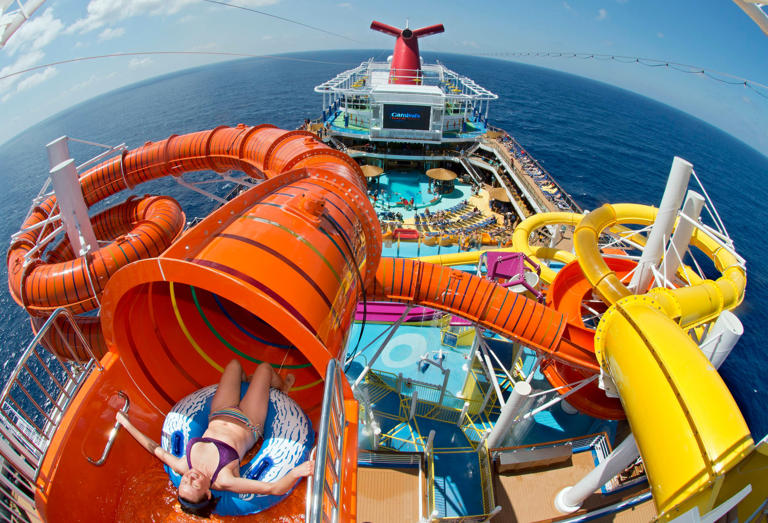

IMAGES
VIDEO
COMMENTS
The arrival of AIDA Cruises' AIDAprima in Hamburg in February is the start of a new dynasty. The 3,268-guest ship and a coming sister AIDAperla sport an almost vertical bow design and a covered front deck. The cheeky way AIDA chose to introduce the new look was to paint big puckered red lips around the bow. Four similar, but larger 5,000 ...
Cruise ships are typically designed with a broad and flat bottom hull, known as a "double-bottom" design. ... metacenter is a hypothetical point that represents the intersection of the line of action of the buoyant force with the vertical axis when a ship is heeled (tilted) due to external forces. It is determined by the shape and ...
The cruise line's newest ships have started to feature this new light blue coloring, with Royal Caribbean choosing to phase out its classic white-colored hulls. In the background of the photos, the construction for Icon of the Seas can also be seen. Construction on Royal Caribbean's newest ship started in June 2021.
A vertical stack of three evenly spaced horizontal lines. ... The new world's largest cruise ship just hit the ocean — take a closer look at the gargantuan 7,600-guest vessel ahead of its 2024 ...
The Plumb, the Clipper and the Spoon. A normal bow, as what we would call it, has developed from its predecessor which was a vertical bow. The angle at which the ship stem makes with the waterline is called the rake. A vertical, or unraked bow having a straight edge is known as a plumb bow. These bows have maximum waterline besides an X-Bow or ...
Carnival Horizon, which begins cruising out of PortMiami to the Caribbean on Sept. 22, is the first ship built for the North America market that is full of so-called smart elevators, 33 of them promising faster times, fewer stops, and a new dimension in vertical transportation.
BOOK NOW. Go big on bold when you sail aboard one of the largest cruise ships in the world. Get ready for a perception remixing, memory maxing mic drop — Symphony of the Seas® is all that and more. It's your favorite onboard hits, including the ten-story test of courage, Ultimate Abyss℠ and twin FlowRider®* surf simulators, plus ...
Mission Success: Costa Concordia Is Vertical : The Two-Way The cruise ship, which ran aground in January 2012 off the coast of Tuscany, will be stabilized and checked to make sure it can make it ...
Find Cruise Ship Vertical stock images in HD and millions of other royalty-free stock photos, illustrations and vectors in the Shutterstock collection. Thousands of new, high-quality pictures added every day.
Download and use 1,000,000+ Cruise Ship High Resolution Vertical Images stock photos for free. Thousands of new images every day Completely Free to Use High-quality videos and images from Pexels
The point at which a vertical line through the heeled centre of buoyancy crosses the line through the original, vertical centre of buoyancy is the metacentre. The metacentre remains directly above the centre of buoyancy by definition. In the diagram above, the two Bs show the centres of buoyancy of a ship in the upright and heeled conditions.
The bottom of a cruise ship is commonly referred to as the "hull.". The hull is the watertight body of the ship, extending from the main deck to the very base. It is integral to buoyancy, stability, and the overall structural framework of the vessel. Built to counteract water pressure, stave off corrosion, and facilitate smooth sailing, the ...
Spoon Bow. Bulbous Bow. Parabolic and Cylindrical Bows. Axe Bows. Inverted Bow. Ram Bow. Conclusion. We will discuss a very important part of a ship or a boat - Bow. Ships and boats face immense resistance on the water for the simple fact that compared to air, water produces more drag when moved through.
Stabilizers serve an essential function on cruise ships. They are fins or rotors beneath the water line, extended from the ship's hull to stabilize the ship and prevent it from rolling. This ...
Much of our public housing stock is ageing and substandard. But we can learn from outstanding examples of retrofit projects that have transformed existing blocks into high-quality housing.
Growing vertical on a cruise ship. The 6,762-passenger MSC World Europa currently docked in Doha, Qatar, is introducing a new restaurant concept, branded the Chef's Garden Kitchen, which is a Babylon Micro-Farms powered hydroponic garden at sea with herbs, greens and garnishes grown onboard. Alexander Olesen, Babylon Micro-Farms Founder and CEO ...
The main benefits of cruise ship stabilizers include increased comfort for passengers and crew, improved safety, and better fuel efficiency. By reducing the rolling and pitching of the ship, stabilizers can help to prevent seasickness, reduce the risk of injury, and improve the stability of the vessel. They also help to reduce fuel consumption ...
After 3,000 people in nine public housing towers in Melbourne were placed under the harshest coronavirus lockdown in Australia so far, acting Australian Chief Medical Officer Paul Kelly referred ...
A vertical stack of three evenly spaced horizontal lines. A magnifying glass. ... Royal Caribbean's second-largest cruise ship, Wonder of the Seas, sailed out of Port Canaveral in 2023.
Vertical integration increases the synergies between cruise ship operations and other business interests, opens the door for product diversification, and emphasizes the link between cruise terminal operations and shore-based activities (i.e. shore excursions or cruise port resorts). ... members Thanos Pallis and Theo Notteboom and Grace Wang ...
The Gyroscopic stabilizers are the type of active cruise ship stabilizer. Mostly, such stabilizers use big wheels or discs to balance the ship's movement. When the ship rolls to one side, the gyroscope spins in the opposite direction, generating a torque that helps stabilize the vessel.
The core consideration for cruise terminal design is related to the expected technical characteristics of the cruise ships. Indicators, such as the tonnage, overall length (LOA), beam, and draft of modern cruise ships, along with the passenger capacity, and the number of crew on board, are the most considered. ... and the absence of vertical ...
We also use lanyards. We go to the front desk and they will punch a hole in the card. (at least on Princess) However, we do NOT use the lanyard ashore. There we put the card in our pockets. We do not want someone mistaking the lanyard for something of value and trying to grab it. Edited March 10, 2015 by paul929207.
The incident, which occurred on the morning of Sunday, May 26, 2024, unfolded while the world's largest cruise ship was en route to Roatan, Honduras, from its homeport of Miami, Florida. At the ...
Cruise line: Royal Caribbean. Length: 1,188 feet. Width: 215 feet. Guest capacity: 7,084. A true wonder, the current biggest ship in the world delights guests every week with a feast of activities ...
Where you'll find it: Royal Caribbean's Wonder of the Seas, Symphony of the Seas, Harmony of the Seas, Oasis of the Seas, Liberty of the Seas and Voyager of the Seas. The Perfect Storm complex ...